Optimal Genetic Design of Type-1 and Interval Type-2 Fuzzy Systems for Blood Pressure Level Classification
Abstract
:1. Introduction
2. Basic Concepts
2.1. Blood Pressure
- 119/79 or less is considered normal BP
- 140/90 or higher is considered high BP
2.2. Type of Blood Pressures
2.3. Hypotension
2.4. Hypertension
2.5. Risk Factors
3. Problem Statement and Proposed Method
3.1. Design of the Type-1 Fuzzy Systems for Classification with Triangular Membership Functions
3.2. Design of the Type-1 FS for Classification with Trapezoidal Membership Functions
3.2.1. Design of the Second FS for the Classification of BP Levels with Trapezoidal Memberships Functions
3.2.2. Genetic Type-1 Fuzzy System with Trapezoidal Membership Functions
3.2.3. Design of the Optimized Type-1 FS for Classification with Trapezoidal Membership Functions
3.3. Design of the Type-1 FS for Classification with Gaussian Membership Functions
3.3.1. Design of the third FS for the Classification of BP Levels with Gaussian Membership Functions
3.3.2. Genetic Type-1 Fuzzy System with Gaussian Membership Functions
3.3.3. Design of the Optimized Type-1 FS for Classification with Gaussians Membership Functions
3.4. Design of the Interval Type-2 FS for Classification with Triangular Membership Functions
3.4.1. Design of the First Interval Type-2 FS for the Classification of BP Levels with Triangular Membership Functions
3.4.2. Optimization of the Triangular Interval Type-2 Fuzzy Inference System with Genetic Algorithm
3.4.3. Design of the Optimized Interval Type-2 FS for Classification with Triangular Membership Functions
3.5. Design of the Interval Type-2 FS for Classification with Trapezoidal Membership Functions
3.5.1. Design of the First Interval Type-2 FS for the Classification of BP Levels with Trapezoidal Memberships Functions
3.5.2. Optimization of the Trapezoidal Type-2 Fuzzy Inference System with Genetic Algorithm
3.5.3. Design of the Optimized Interval Type-2 FS for Classification with Trapezoidal MFs
3.6. Design of the Interval Type-2 FS for Classification with Gaussians Membership Functions
3.6.1. Design of the First Interval Type-2 Fuzzy System for the Classification of BP Levels with Gaussians Memberships Functions
3.6.2. Optimization of the Gaussian Type-2 Fuzzy Inference System with Genetic Algorithm
3.6.3. Design of the Optimized Interval Type 2 FS for Classification with Gaussians Membership Functions
3.6.4. Fuzzy Rules for the Type-1 and Interval Type-2 FS with the Different Architectures.
- If (Systolic is Low) and (Diastolic is Low) then (BP_Levels is Hypotension)
- If (Systolic is Low_Normal) and (Diastolic is Low_Normal) then (BP_Levels is Optimal)
- If (Systolic is Normal) and (Diastolic is Normal) then (BP_Levels is Normal)
- If (Systolic is High_Normal) and (Diastolic is High_Normal) then (BP_Levels is High_Normal)
- If (Systolic is High) and (Diastolic is High) then (BP_Levels is Grade_1)
- If (Systolic is Very_high) and (Diastolic is Very_High) then (BP_Levels is Grade_2)
- If (Systolic is too_high) and (Diastolic is Too_High) then (BP_Levels is Grade_3)
- If (Systolic is Very_high) and (Diastolic is High) then (BP_Levels is Grade_2)
- If (Systolic is too_high) and (Diastolic is Very_High) then (BP_Levels is Grade_3)
- If (Systolic is too_high) and (Diastolic is High) then (BP_Levels is Grade_3)
- If (Systolic is High) and (Diastolic is Very_High) then (BP_Levels is Grade_2)
- If (Systolic is High) and (Diastolic is Too_High) then (BP_Levels is Grade_3)
- If (Systolic is Very_high) and (Diastolic is Too_High) then (BP_Levels is Grade_3)
- If (Systolic is High) and (Diastolic is Normal) then (BP_Levels is ISHGRADE_1)
- If (Systolic is High) and (Diastolic is High_Normal) then (BP_Levels is ISHGRADE_1)
- If (Systolic is Very_high) and (Diastolic is Normal) then (BP_Levels is ISHGRADE_2)
- If (Systolic is Very_high) and (Diastolic is High_Normal) then (BP_Levels is ISHGRADE_2)
- If (Systolic is too_high) and (Diastolic is Normal) then (BP_Levels is ISHGRADE_3)
- If (Systolic is too_high) and (Diastolic is High_Normal) then (BP_Levels is ISHGRADE_3)
- If (Systolic is Normal) or (Diastolic is Normal) then (BP_Levels is Normal)
- If (Systolic is High_Normal) or (Diastolic is High_Normal) then (BP_Levels is High_Normal)
4. Knowledge Representation of the Optimized Type-1 and Interval Type-2 Fuzzy Systems
4.1. Input and Output Variables for Triangular Type-1 Fuzzy System
4.1.1. Input Variables
4.1.2. Output Variable
4.2. Knowledge Representation of Triangular, Trapezoidal and Gaussian Type-2 Membership Function for Interval Type-2 Fuzzy Systems
4.2.1. Triangle Interval Type-2 Membership Functions with Uncertainty , and
4.2.1.1. Input variables for triangular type-2 fuzzy system
4.2.1.2. Output variables for triangular type-2 fuzzy system
4.2.2. Trapezoidal Interval Type-2 Membership Functions with Uncertain , , and
4.2.3. Interval Type-2 Gaussian Membership Function
5. Results of This Work
6. Discussion
7. Conclusions
Author Contributions
Funding
Acknowledgments
Conflicts of Interest
References
- Yang, X.S.; Karamanoglu, M.; He, X. Flower pollination algorithm: A novel approach for multiobjective optimization. Eng. Optim. 2014, 46, 1222–1237. [Google Scholar] [CrossRef]
- Yu, J.J.Q.; Li, V.O.K. A social spider algorithm for global optimization. Appl. Soft Comput. 2015, 30, 614–627. [Google Scholar] [CrossRef] [Green Version]
- Meng, X.-B.; Gao, X.Z.; Lu, L.; Liu, Y.; Zhang, H. A new bio-inspired optimisation algorithm: Bird Swarm Algorithm. J. Exp. Theor. Artif. Intell. 2016, 28, 673–687. [Google Scholar] [CrossRef]
- Gopinathannair, R.; Olshansky, B. Management of tachycardia. F1000Prime Rep. 2015, 7, 60. [Google Scholar] [CrossRef] [PubMed]
- Wilson, J.M. Essential Cardiology: Principles and Practice. Tex. Heart Inst. J. 2005, 32, 616. [Google Scholar]
- Lai, C.; Coulter, S.A.; Woodruff, A. Hypertension and Pregnancy. Tex. Heart Inst. J. 2017, 5, 350–351. [Google Scholar] [CrossRef]
- Guzman, J.C.; Melin, P.; Prado-Arechiga, G. Design of an optimized fuzzy classifier for the diagnosis of blood pressure with a new computational method for expert rule optimization. Algorithms 2017, 10, 79. [Google Scholar] [CrossRef]
- Guzmán, J.C.; Melin, P.; Prado-Arechiga, G. Neuro-Fuzzy Hybrid Model for the Diagnosis of Blood Pressure. In Nature-Inspired Design of Hybrid Intelligent Systems; Melin, P., Castillo, O., Kacprzyk, J., Eds.; Springer International Publishing: Cham, Switaerland, 2017; pp. 573–582. [Google Scholar]
- Guzmán, J.C.; Melin, P.; Prado-Arechiga, G. Design of a Fuzzy System for Diagnosis of Hypertension. In Design of Intelligent Systems Based on Fuzzy Logic, Neural Networks and Nature-Inspired Optimization; Springer International Publishing: Cham, Switaerland, 2015; pp. 517–526. [Google Scholar]
- Karami, Y.; Fathy, M.; Khakzad, H.; Shirazi, H.; Arab, S. Protein structure prediction using bio-inspired algorithm: A review. In Proceedings of the 16th CSI International Symposium on Artificial Intelligence and Signal Processing (AISP 2012), Shiraz, Iran, 2–3 May 2012; pp. 201–206. [Google Scholar]
- Sari, I.R.F. Bioinspired algorithms for Internet of Things network. In Proceedings of the 2017 4th International Conference on information Technology, Computer, and Electrical Engineering (ICITACEE), Semarang, Indonesia, 18–19 October 2017; p. 1. [Google Scholar]
- Udo, E.U.; Oparaku, O.U. Fuzzy Logic System for Fetal Heart Rate Determination. Int. J. Eng. Res. 2015, 4, 60–63. [Google Scholar]
- Battegay, E.J.; Lip, G.Y.H.; Bakris, G.L. Hypertension: Principles and Practices; Taylor & Francis: Boca Raton, FL, USA, 2005. [Google Scholar]
- Carretero, O.A.; Oparil, S. Essential Hypertension. Circulation 2000, 101, 329–335. [Google Scholar] [CrossRef] [Green Version]
- Zadeh, L.A. Fuzzy sets. Inf. Control 1965, 8, 338–353. [Google Scholar] [CrossRef] [Green Version]
- Carvajal, O.R.; Castillo, O.; Soria, J.J. Optimization of Membership Function Parameters for Fuzzy Controllers of an Autonomous Mobile Robot Using the Flower Pollination Algorithm. J. Autom. Mob. Robot. Intell. Syst. 2018, 12, 44–49. [Google Scholar]
- Domanal, S.; Guddeti, R.M.; Buyya, R. A Hybrid Bio-Inspired Algorithm for Scheduling and Resource Management in Cloud Environment. IEEE Trans. Serv. Comput. 2017. [Google Scholar] [CrossRef]
- Haupt, R.L.; Haupt, S.E. Practical Genetic Algorithms, 2nd ed.; A Wiley-Interscience Publication: Hoboken, NJ, USA, 2004. [Google Scholar]
- Kennedy, J.; Eberhart, R. Particle swarm optimization. In Proceedings of the IEEE International Conference on Neural Networks, Perth, Australia, 27 November–1 December 1995; Volume 4, pp. 1942–1948. [Google Scholar]
- American Heart Association. 2015. Available online: http://www.heart.org/HEARTORG/Conditions/HighBloodPressure/High-Blood-Pressure-or-Hypertension_UCM_002020_SubHomePage.jsp (accessed on 9 July 2016).
- Kenney, L.; Humphrey, R.; Mahler, D.; Brayant, C. ACSM’s Guidelines for Exercise Testing and Prescription; Williams & Wilkins: Philadelphia, PA, USA, 1995. [Google Scholar]
- Mangrum, J.M.; DiMarco, J.P. The Evaluation and Management of Bradycardia. N. Engl. J. Med. 2000, 342, 703–709. [Google Scholar] [CrossRef] [PubMed]
- Mancia, G.; Grassi, G.; Kjeldsen, S.E. Manual of Hypertension of the European Society of Hypertension; Informa Healtcare: London, UK, 2008. [Google Scholar]
- Wizner, B.; Gryglewska, B.; Gasowski, J.; Kocemba, J.; Grodzicki, T. Normal blood pressure values as perceived by normotensive and hypertensive subjects. J. Hum. Hypertens. 2003, 17, 87–91. [Google Scholar] [CrossRef] [Green Version]
- Duodu, Q.; Panford, J.K.; Hafron-acquah, J.B. Designing Algorithm for Malaria Diagnosis using Fuzzy Logic for Treatment (AMDFLT) in Ghana. Int. J. Comput. Appl. 2014, 91, 17. [Google Scholar] [CrossRef]
- Morsi, I.; el Gawad, Y.Z.A. Fuzzy logic in heart rate and blood pressure measuring system. In Proceedings of the 2013 IEEE Sensors Applications Symposium Proceedings, Galveston, TX, USA, 19–21 February 2013; pp. 113–117. [Google Scholar]
- Nohria, R.; Mann, P.S. Diagnosis of Hypertension using Adaptive Neuro-Fuzzy Inference System. Int. J. Comput. Sci. Technol. 2015, 8491, 36–40. [Google Scholar]
- Sikchi, S.; Ali, M. Design of fuzzy expert system for diagnosis of cardiac diseases. Int. J. Med. Sci. Public Heal. 2013, 2, 56. [Google Scholar] [CrossRef]
- Rosendorff, C. Essential Cardiology, 3rd ed.; Springer: Bronx, NY, USA, 2013. [Google Scholar]
- Melin, P.; Castillo, O. Hybrid Intelligent Systems for Pattern Recognition Using Soft Computing; Springer-Verlag: Berlin/Heidelberg, Germany, 2005. [Google Scholar]
- Asl, A.A.S.; Zarandi, M.H.F. A Type-2 Fuzzy Expert System for Diagnosis of Leukemia. In Fuzzy Logic in Intelligent System Design, Proceedings of the North American Fuzzy Information Processing Society Annual Conference, Cancun, Mexico, 16–18 October 2017; Springer: Cham, Switzerland, 2017; pp. 52–60. [Google Scholar]
- Sotudian, S.; Zarandi, M.H.F.; Turksen, I.B. From Type-I to Type-II Fuzzy System Modeling for Diagnosis of Hepatitis. World Acad. Sci. Eng. Technol. Int. J. Comput. Electr. Autom. Control Inf. Eng. 2016, 10, 1280–1288. [Google Scholar]
- Miramontes, I.; Martínez, G.; Melin, P.; Prado-Arechiga, G. A Hybrid Intelligent System Model for Hypertension Risk Diagnosis. In Fuzzy Logic in Intelligent System Design, Proceedings of the North American Fuzzy Information Processing Society Annual Conference, Cancun, Mexico, 16–18 October 2017; Springer: Cham, Switzerland, 2017; pp. 202–213. [Google Scholar]
- Melin, P.; Miramontes, I.; Prado-Arechiga, G. A hybrid model based on modular neural networks and fuzzy systems for classification of blood pressure and hypertension risk diagnosis. Expert Syst. Appl. 2018, 107, 146–164. [Google Scholar] [CrossRef]
- Miramontes, I.; Martínez, G.; Melin, P.; Prado-Arechiga, G. A Hybrid Intelligent System Model for Hypertension Diagnosis BT. In Nature-Inspired Design of Hybrid Intelligent Systems; Melin, P., Castillo, O., Kacprzyk, J., Eds.; Springer International Publishing: Cham, Switaerland, 2017; pp. 541–550. [Google Scholar]
- Zarandi, M.H.F.; Khadangi, A.; Karimi, F.; Turksen, I.B. A Computer-Aided Type-II Fuzzy Image Processing for Diagnosis of Meniscus Tear. J. Digit. Imaging 2016, 29, 677–695. [Google Scholar] [CrossRef] [Green Version]
- Pabbi, V. Fuzzy Expert System for Medical Diagnosis. Int. J. Sci. Res. Publ. 2015, 5, 1–7. [Google Scholar]
- Mohamed, K.A.; Hussein, E.M. Malaria Parasite Diagnosis using Fuzzy Logic. Int. J. Sci. Res. 2016, 5, 2015–2017. [Google Scholar]
- Melin, P.; Prado-Arechiga, G. New Hybrid Intelligent Systems for Diagnosis and Risk Evaluation of Arterial Hypertension; Springer: Cham, Switzerland, 2018. [Google Scholar]
- O’Brien, E.; Parati, G.; Stergiou, G. Ambulatory Blood Pressure Measurement. Hypertension 2013, 62, 988–994. [Google Scholar] [CrossRef] [Green Version]
- Słowiński, K. Rough Classification of HSV Patients. In Intelligent Decision Support. Theory and Decision Library (Series D: System Theory, Knowledge Engineering and Problem Solving); Słowiński, R., Ed.; Springer: Dordrecht, The Netherlands, 1992; Volume 11. [Google Scholar]
- Yuksel, S.; Dizman, T.; Yildizdan, G.; Sert, U. Application of soft sets to diagnose the prostate cancer risk. J. Inequal. Appl. 2013, 2013, 229. [Google Scholar] [CrossRef] [Green Version]
- Galilea, E.H.; Santos-García, G.; Suárez-Bárcena, I.F. Identification of Glaucoma Stages with Artificial Neural Networks Using Retinal Nerve Fibre Layer Analysis and Visual Field Parameters. In Innovations in Hybrid Intelligent Systems. Advances in Soft Computing; Corchado, E., Corchado, J.M., Abraham, A., Eds.; Springer: Berlin/Heidelberg, Germany, 2007; Volume 44. [Google Scholar]
- Alcantud, J.C.R.; Santos-García, G.; Hernández-Galilea, E. Glaucoma Diagnosis: A Soft Set Based Decision Making Procedure. In Advances in Artificial Intelligence, Proceedings of the Conference of the Spanish Association for Artificial Intelligence, Albacete, Spain, 9–12 November 2015; Lecture Notes in Computer Science; Puerta, J., Ed.; Springer: Cham, Switzerland, 2015; Volume 9422. [Google Scholar]
- José Carlos, R. Alcantud, Alessio Emanuele Biondo, Alfio Giarlotta: Fuzzy politics I: The genesis of parties. Fuzzy Sets Syst. 2018, 349, 71–98. [Google Scholar]
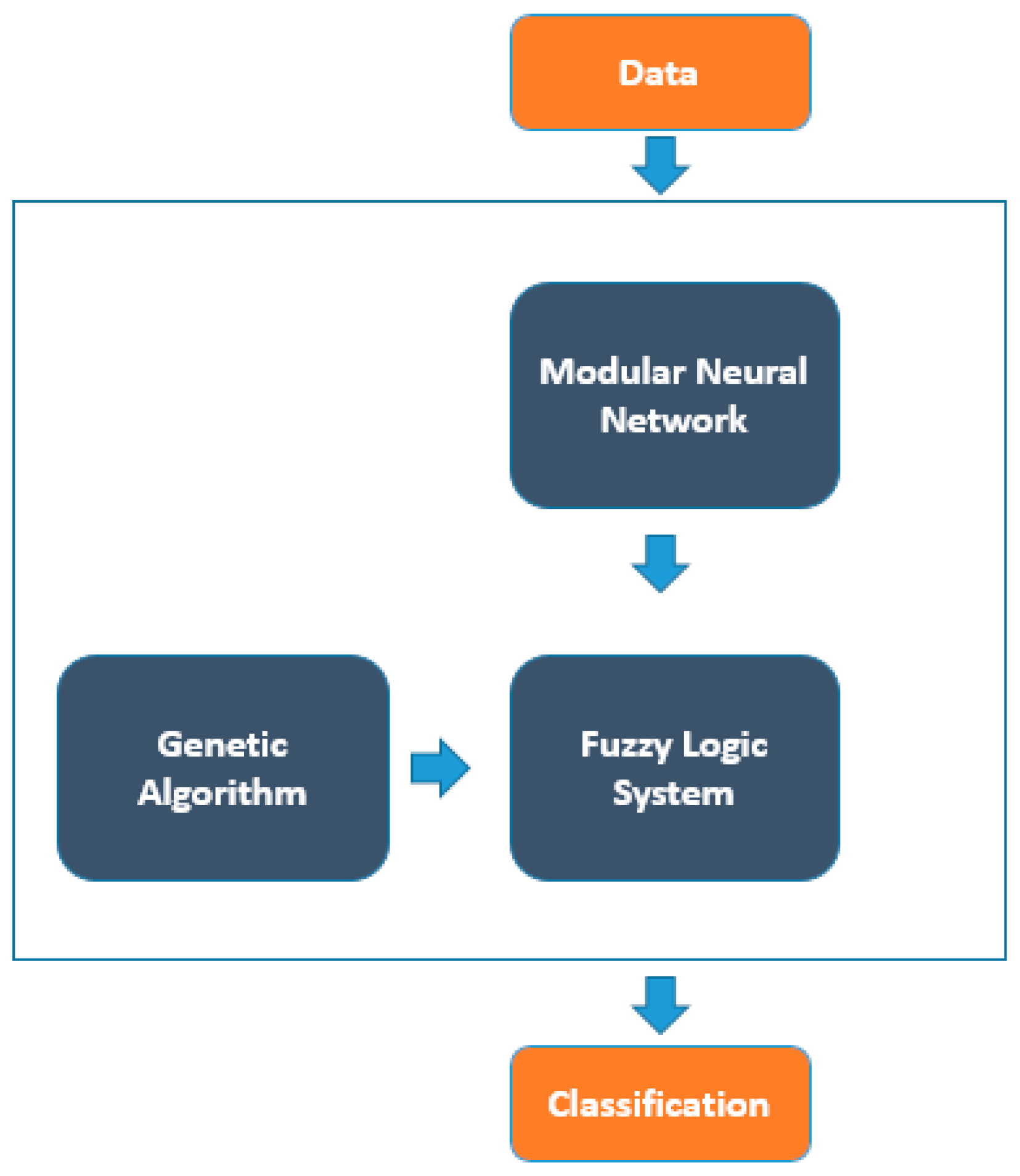

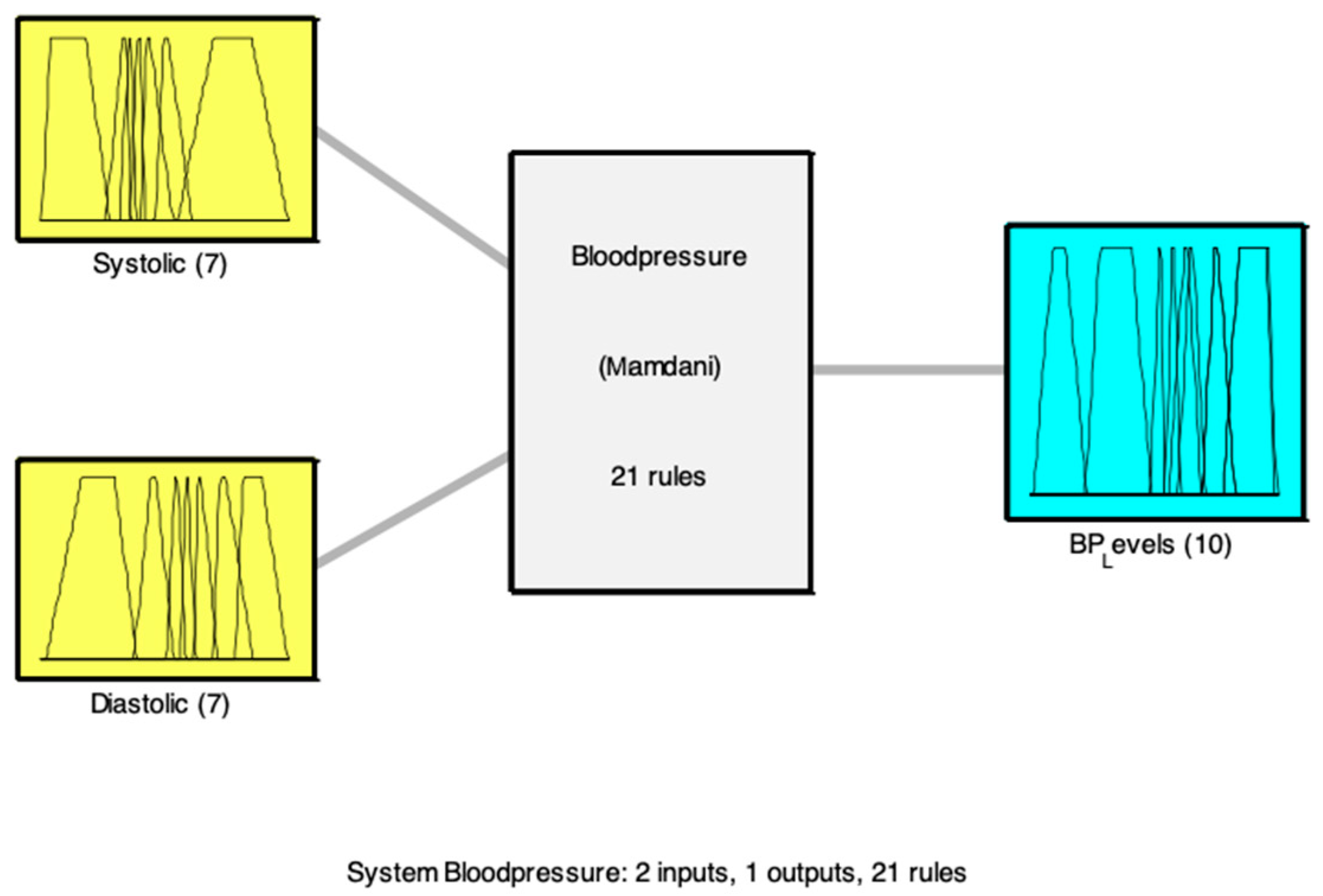
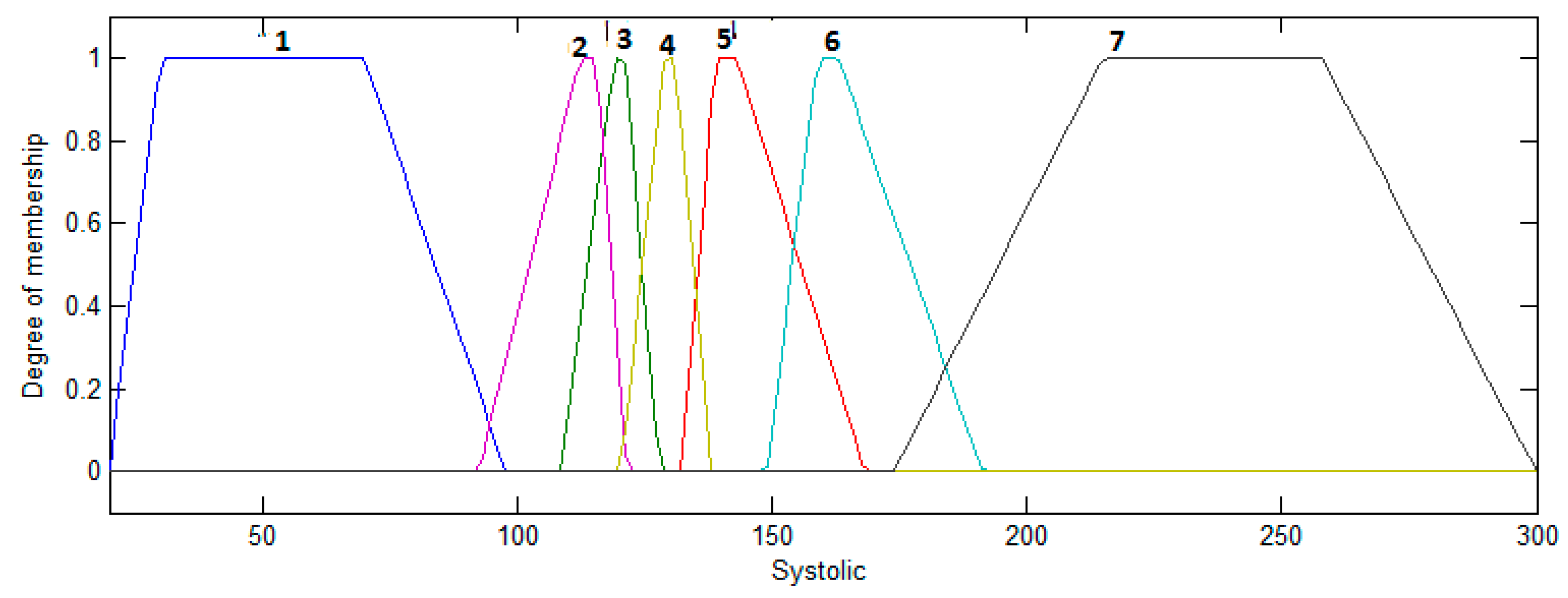

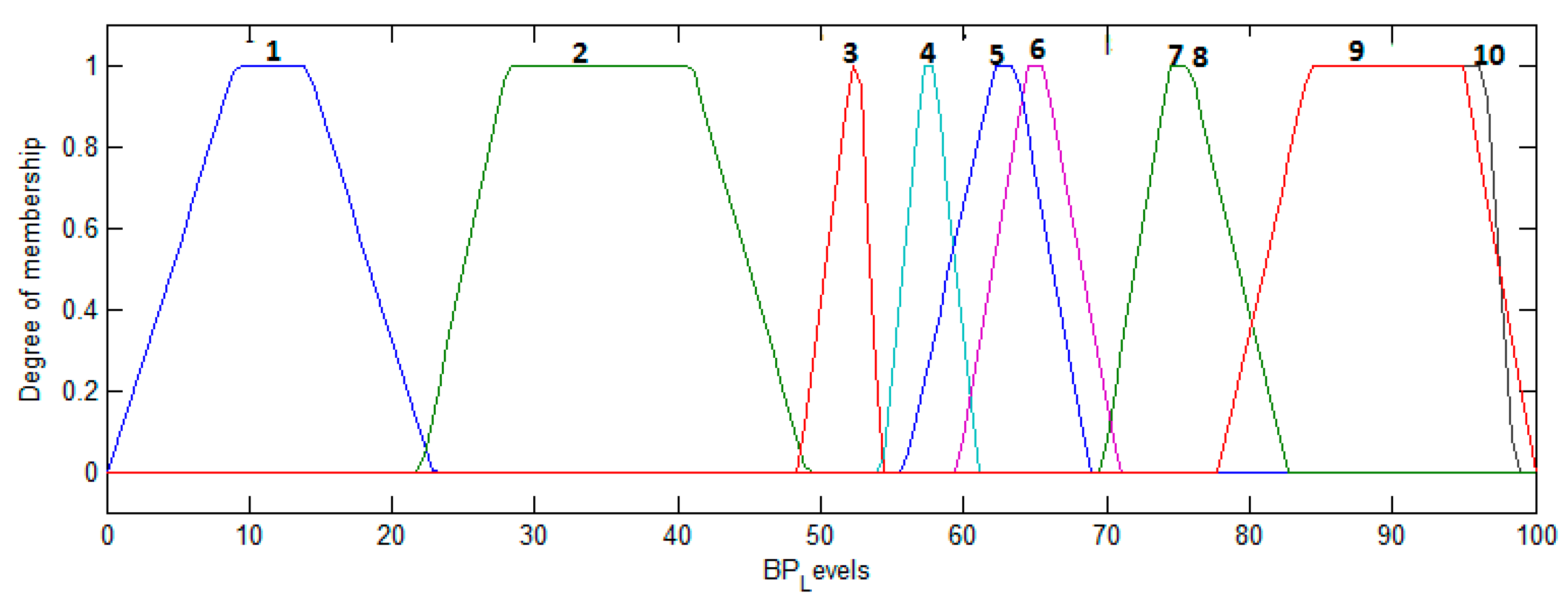

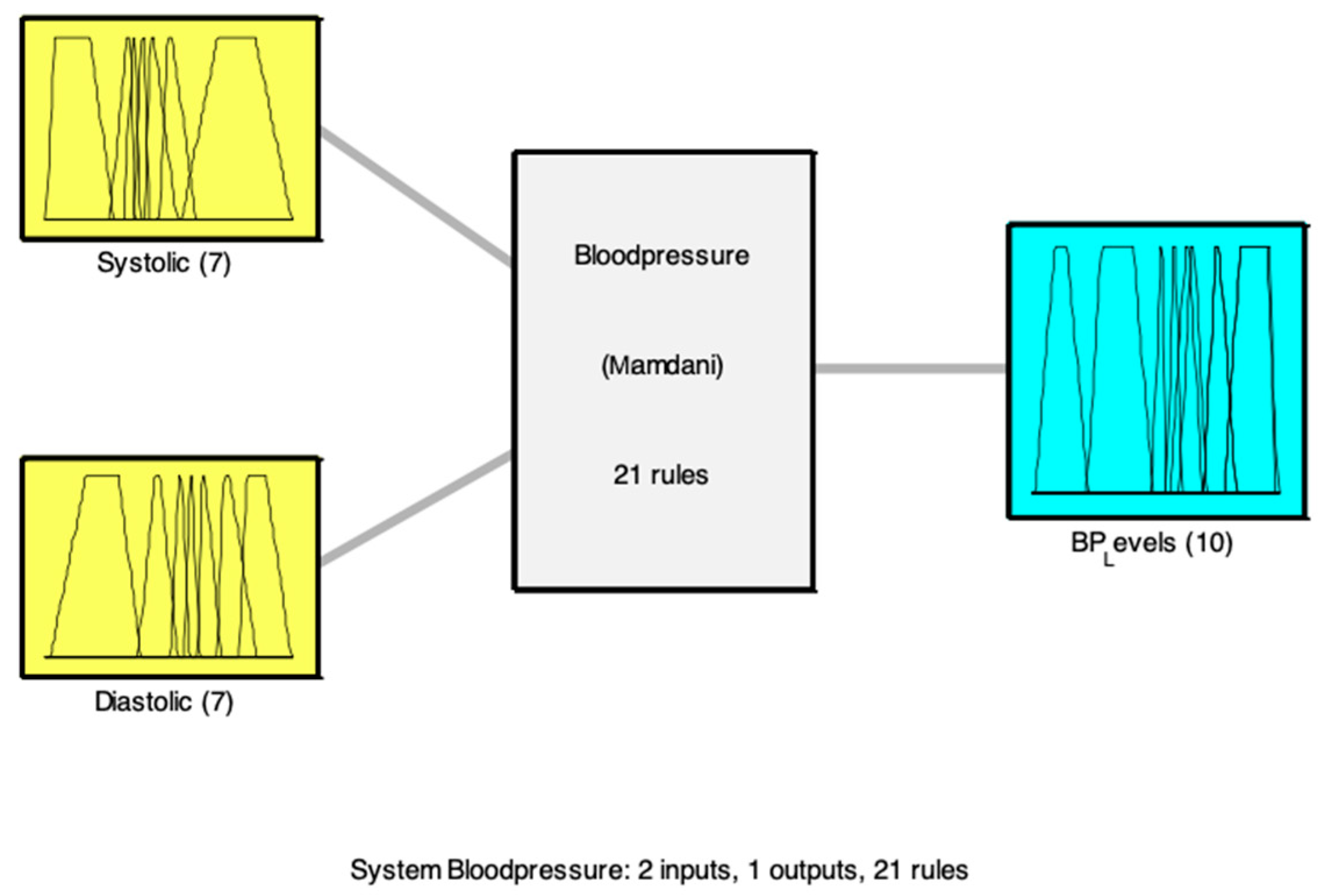
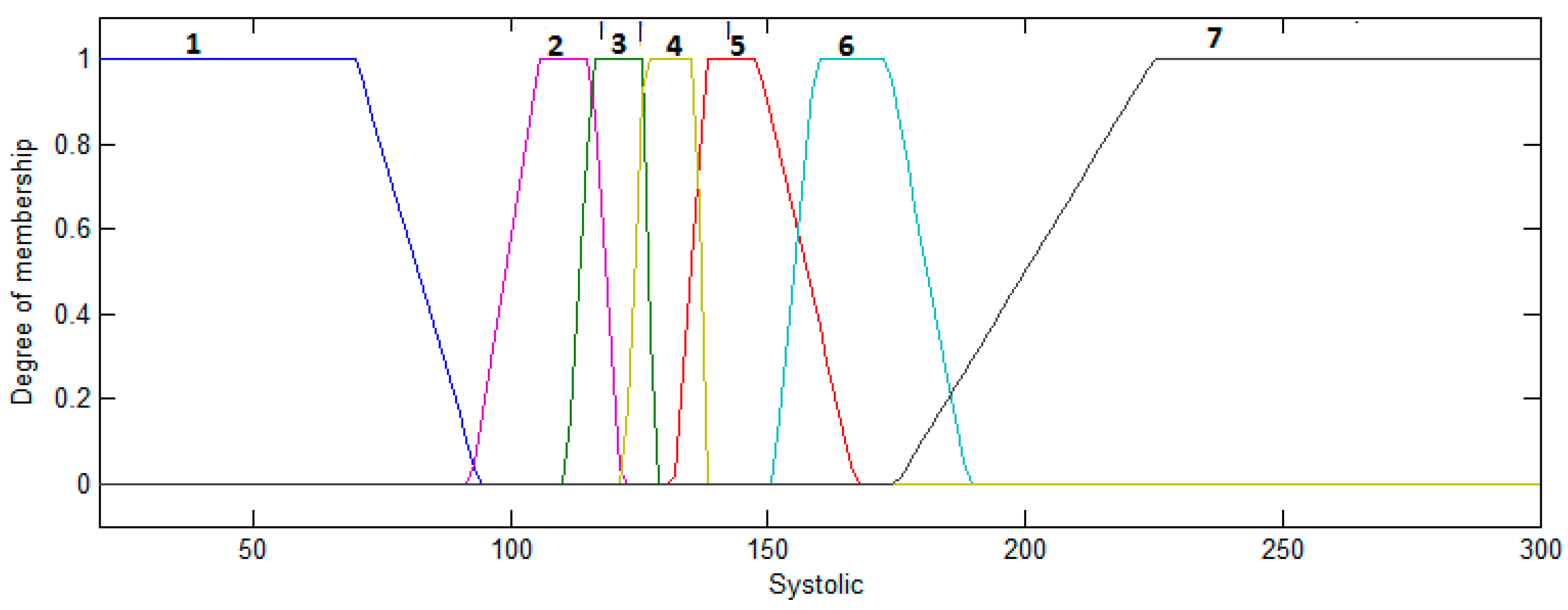


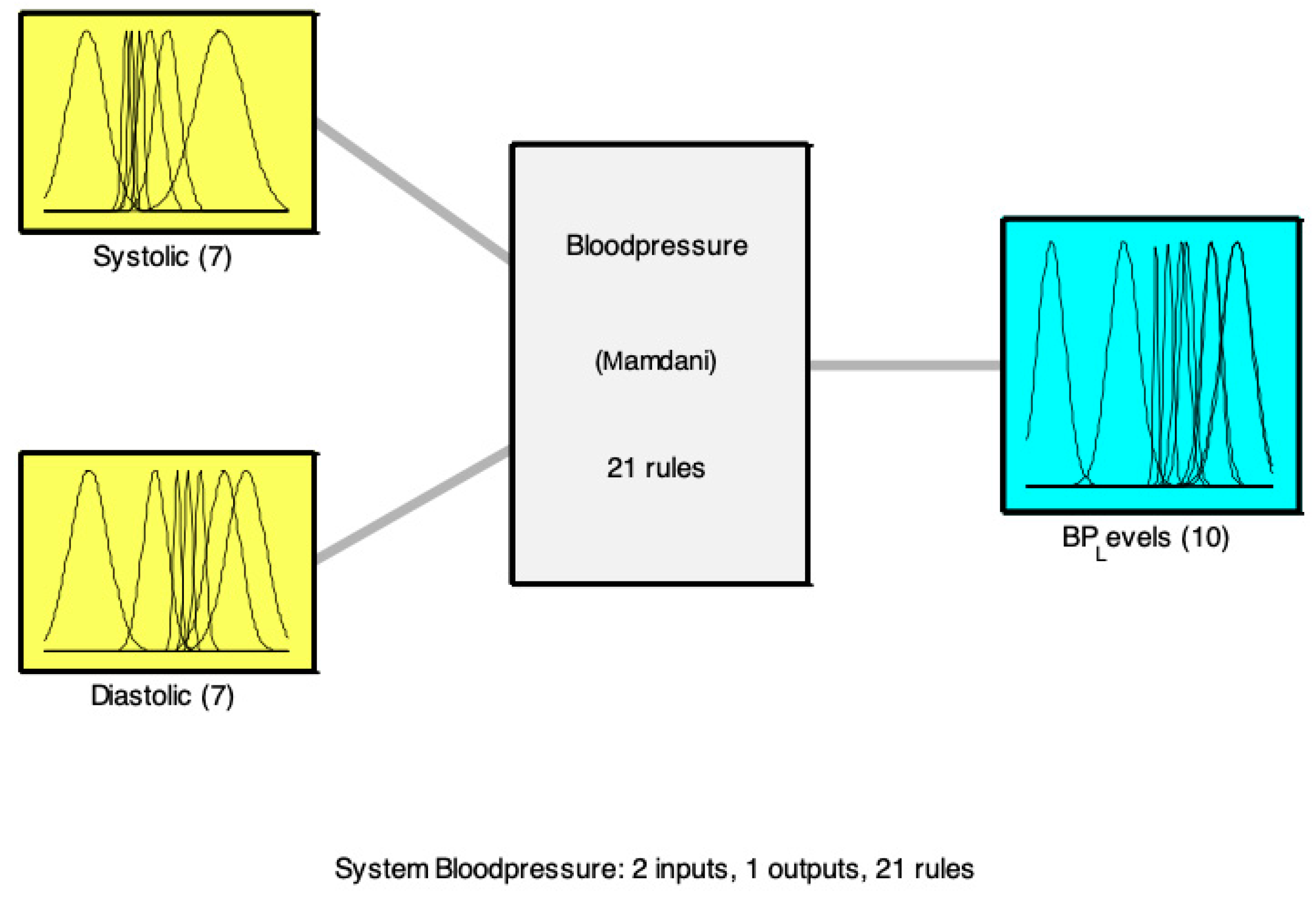
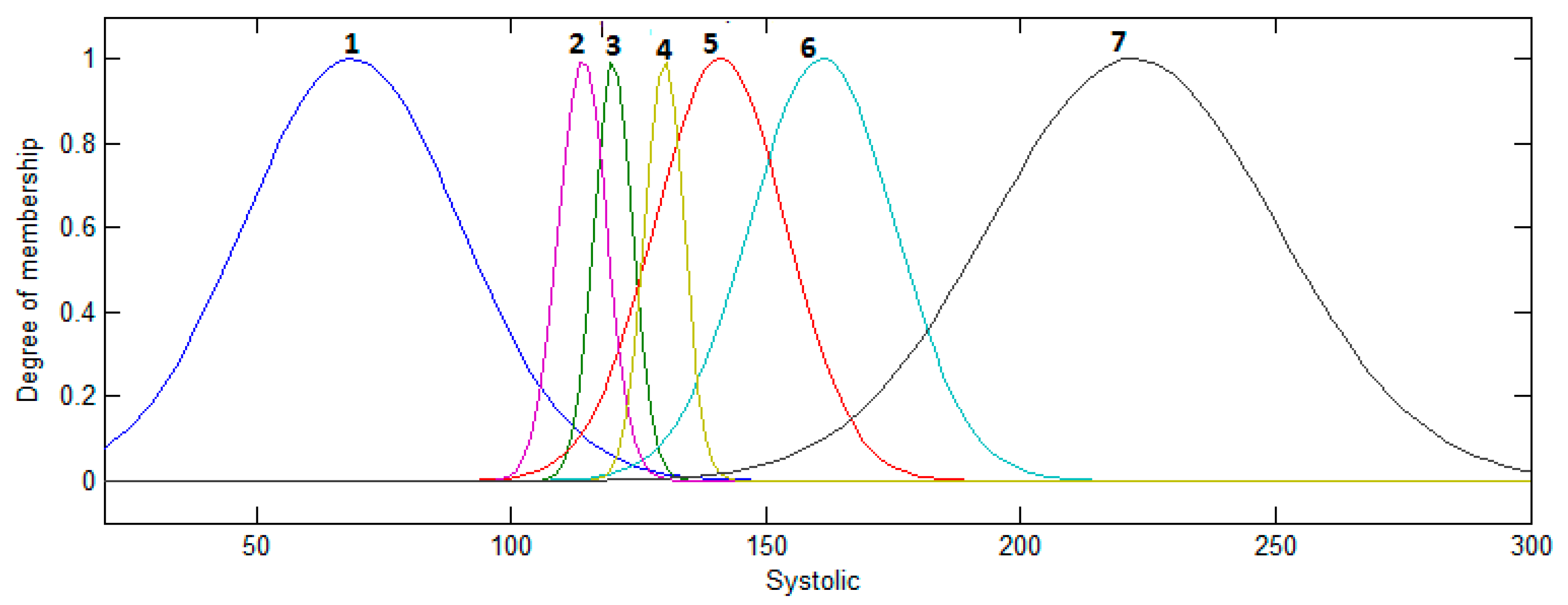

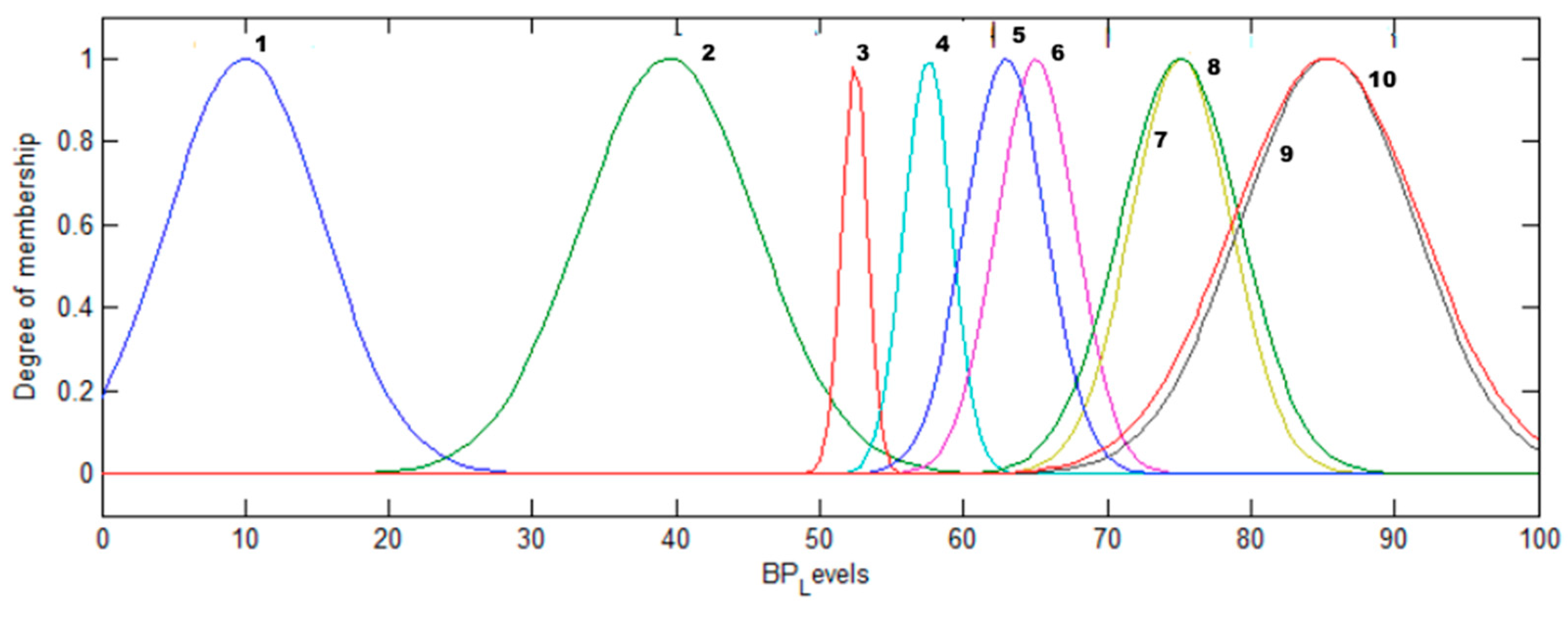

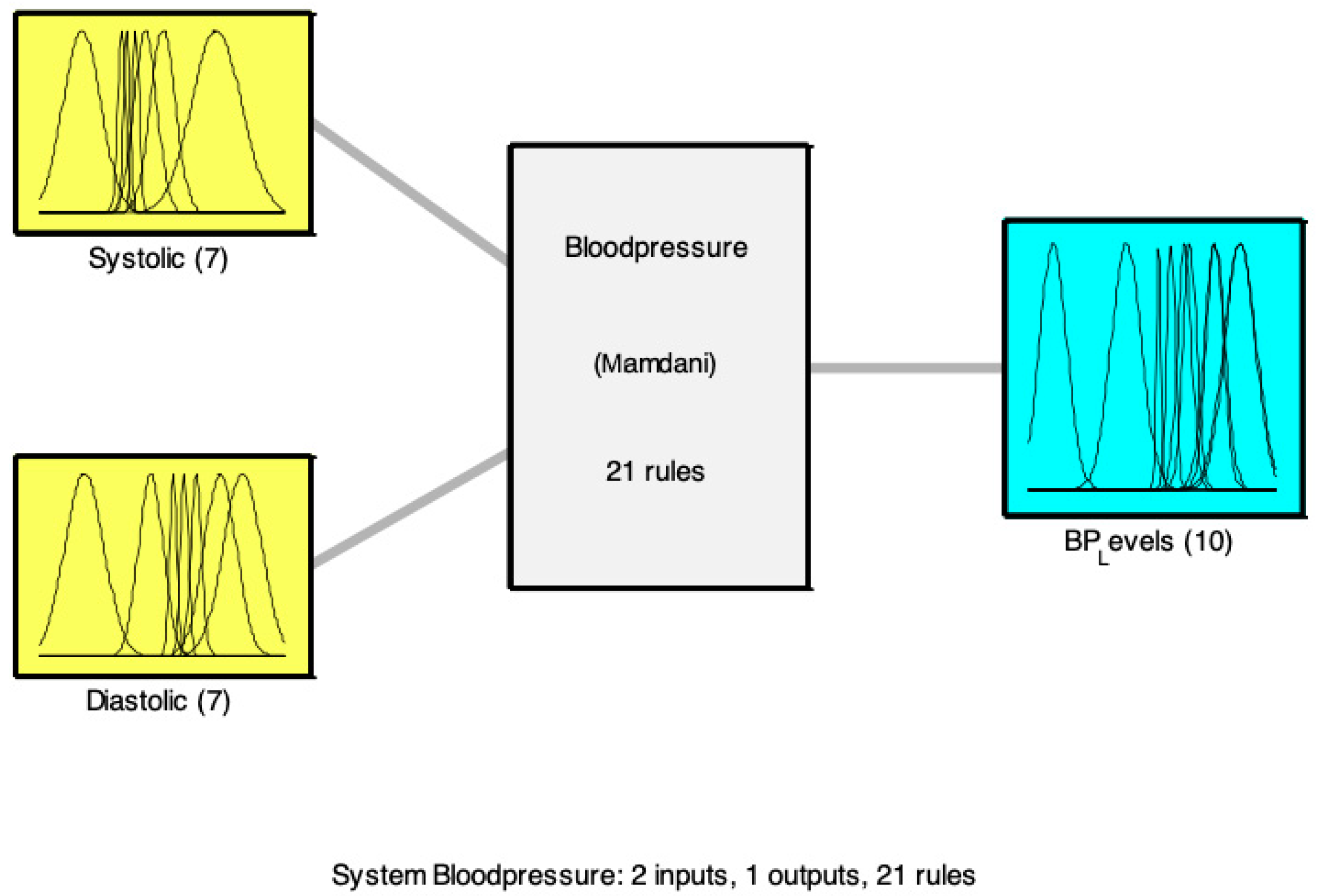
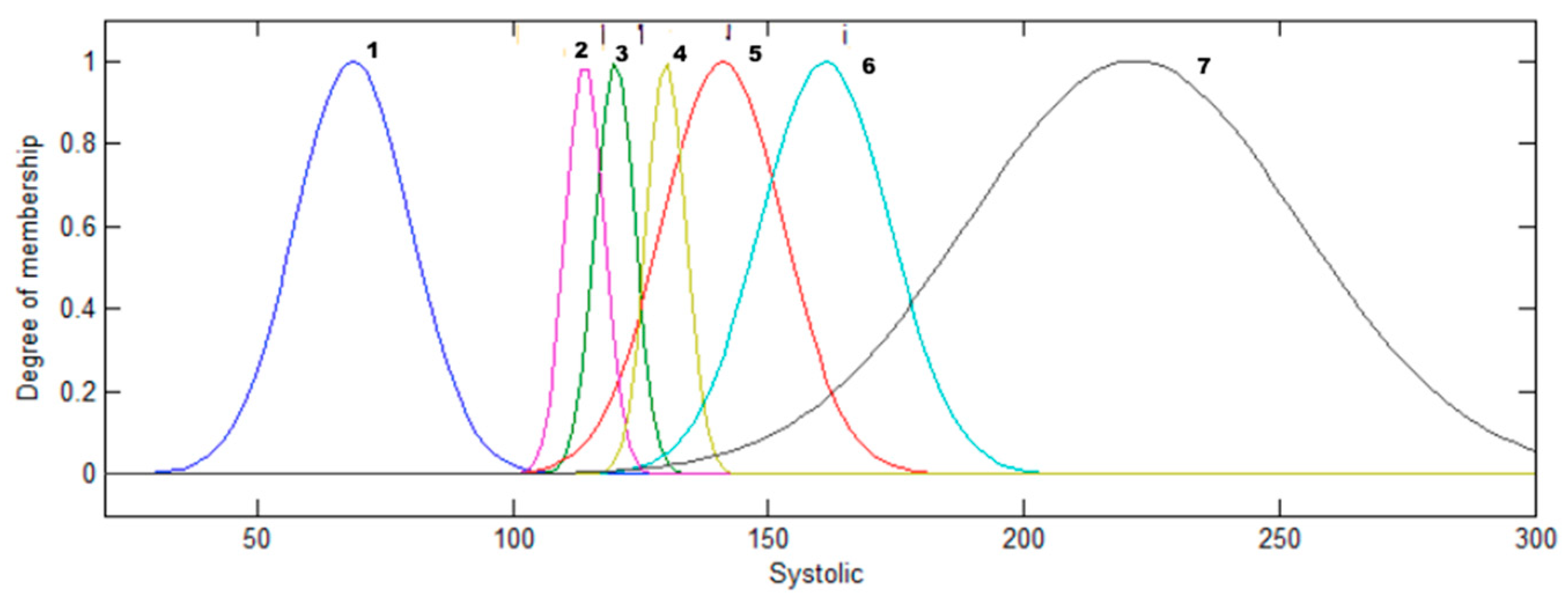
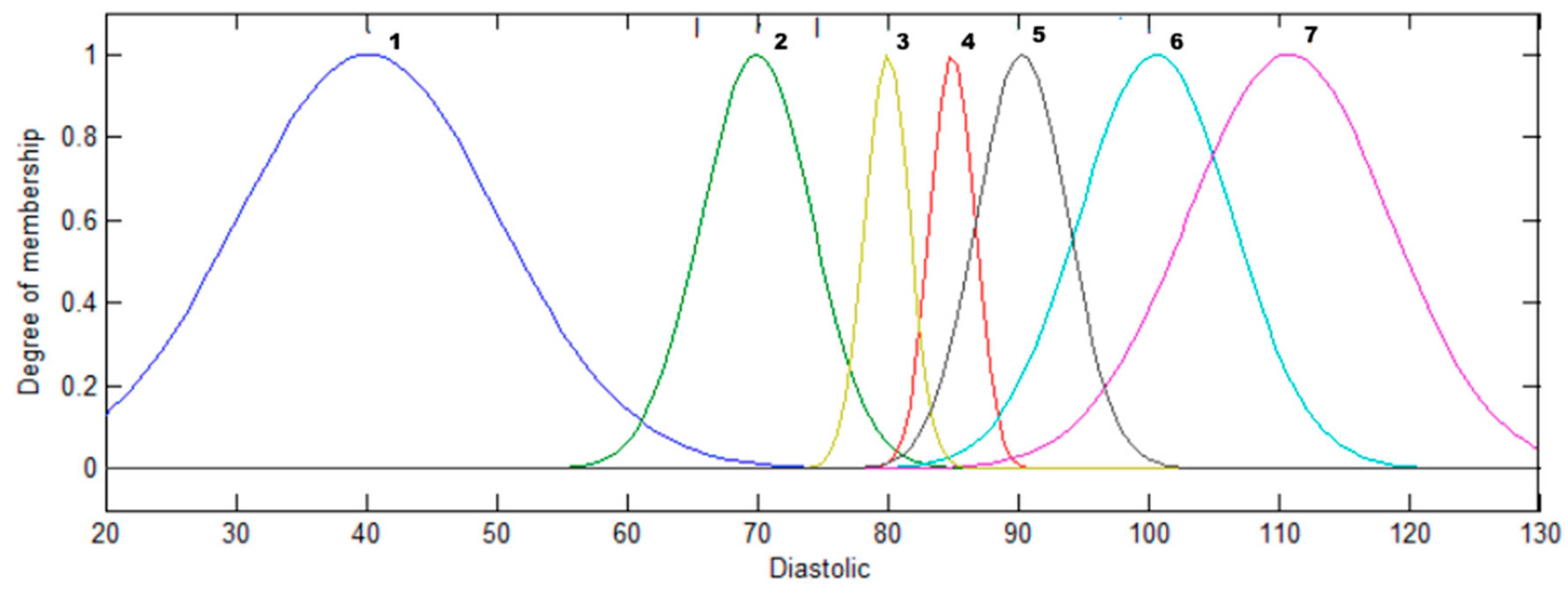
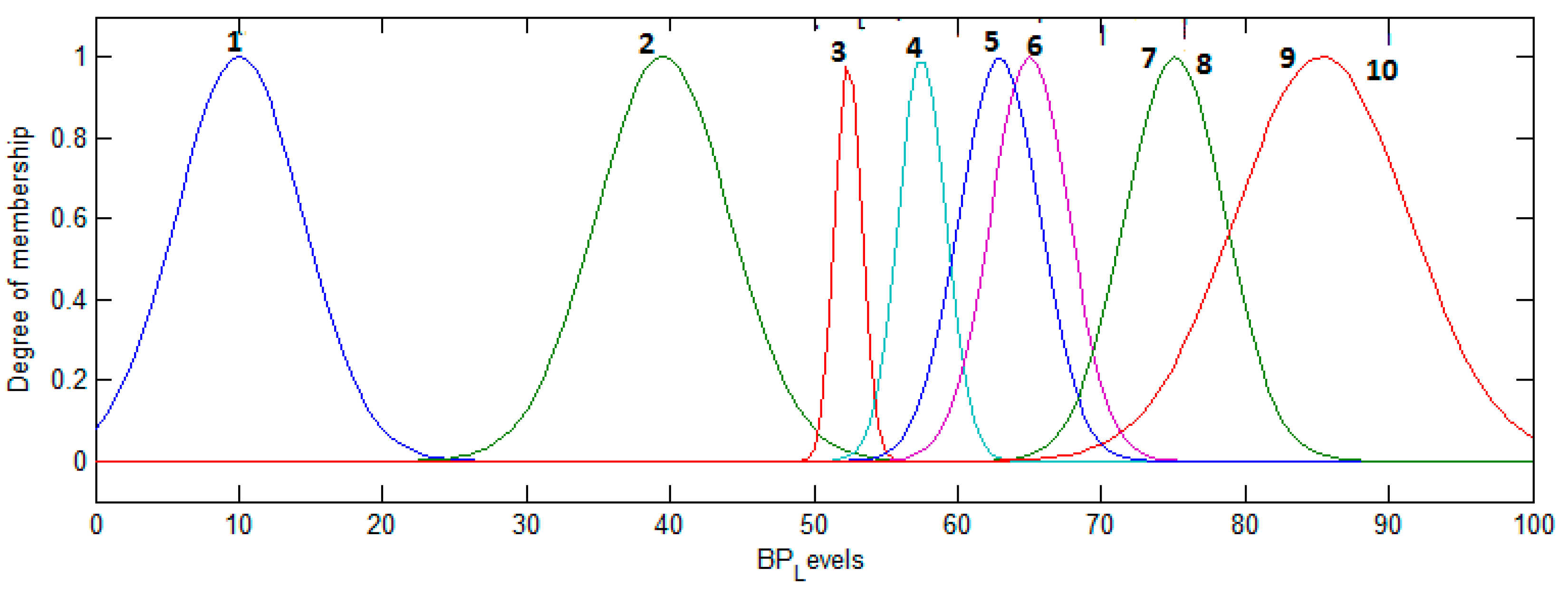
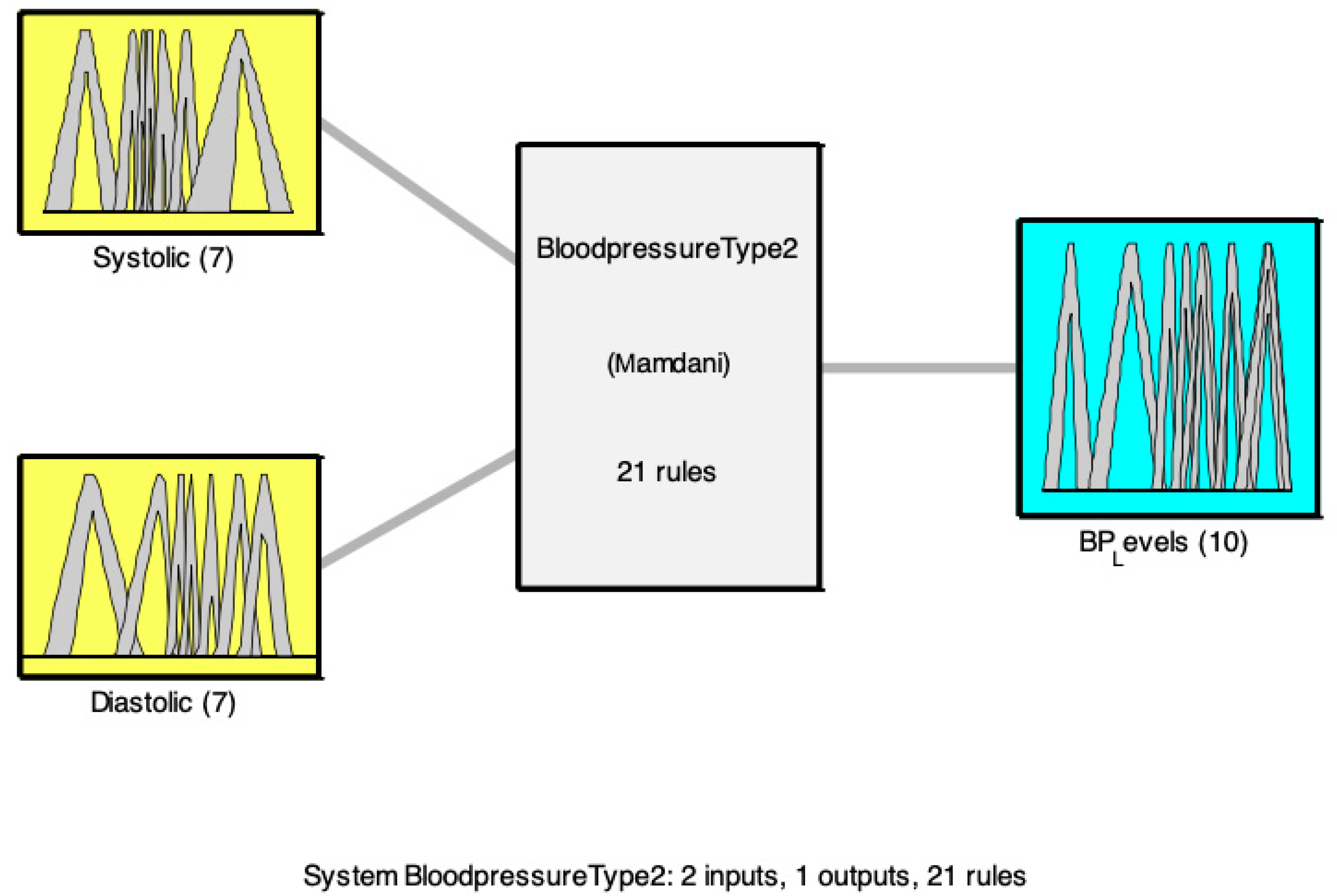
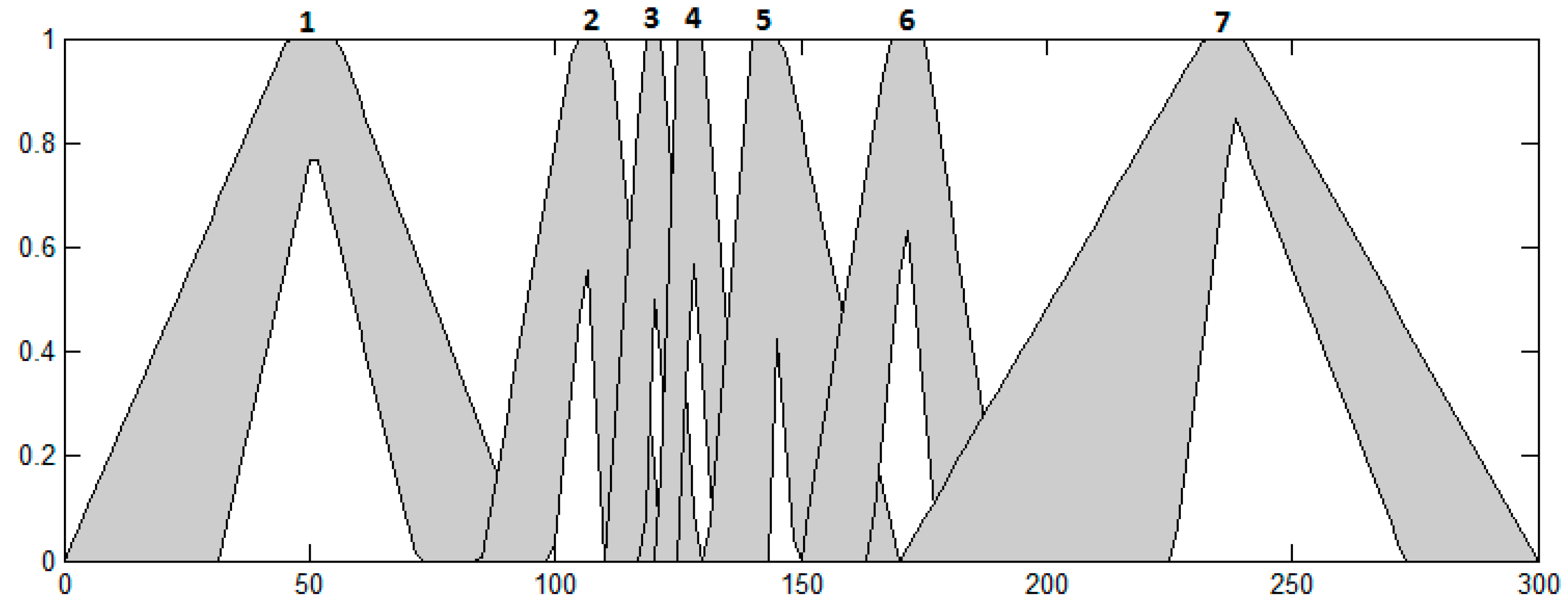
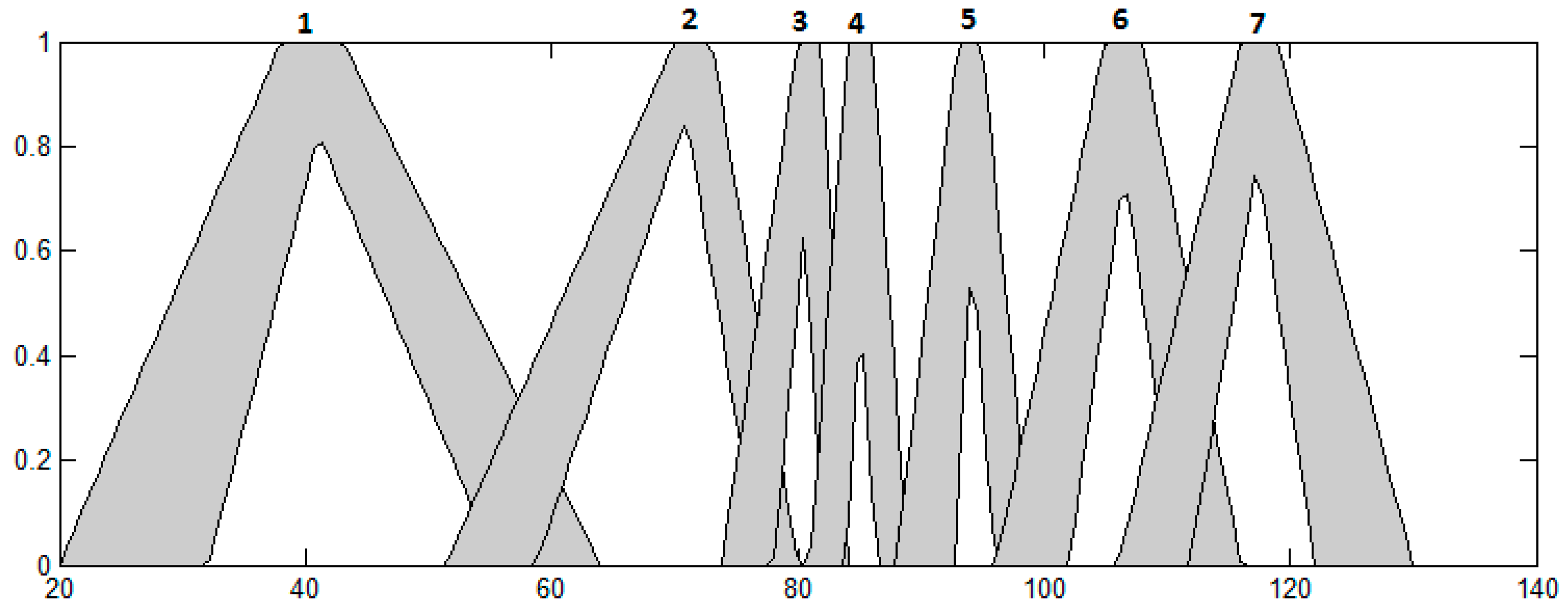
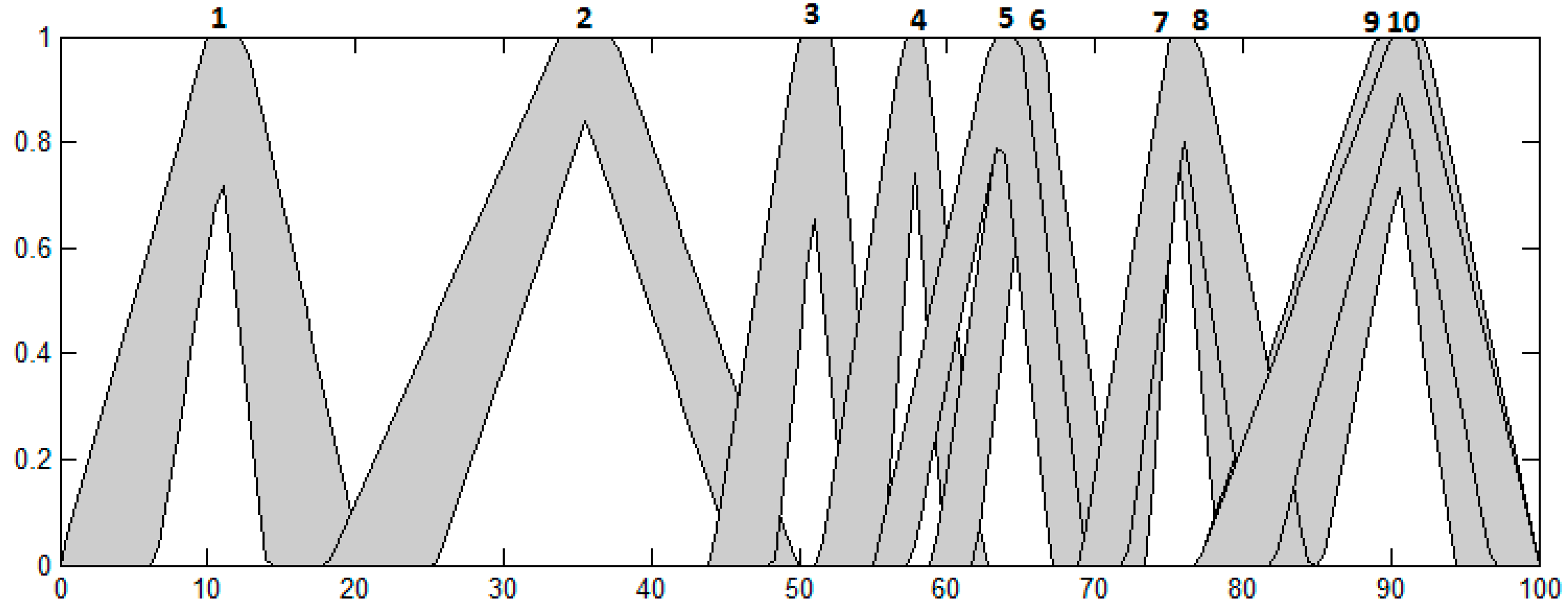

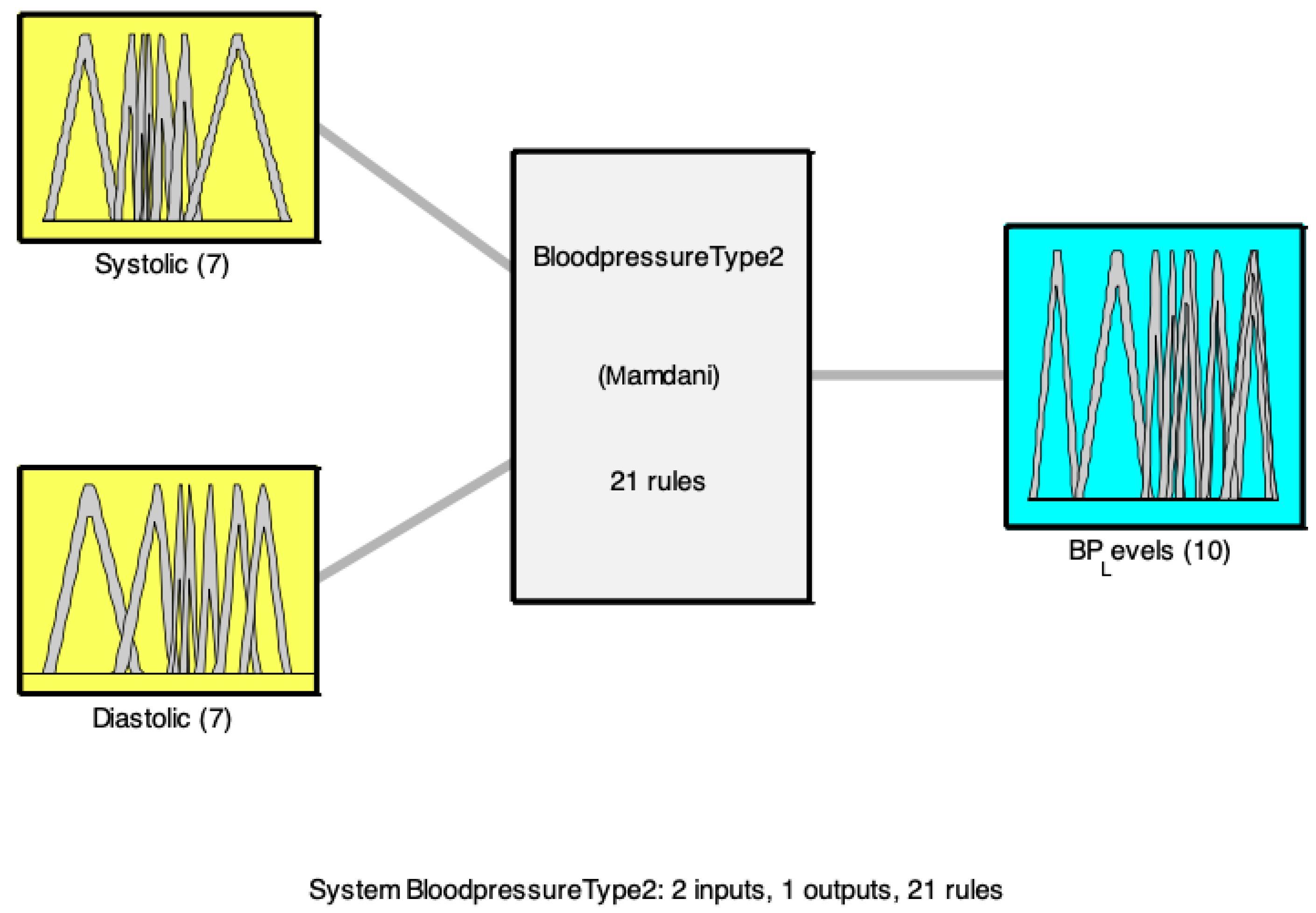

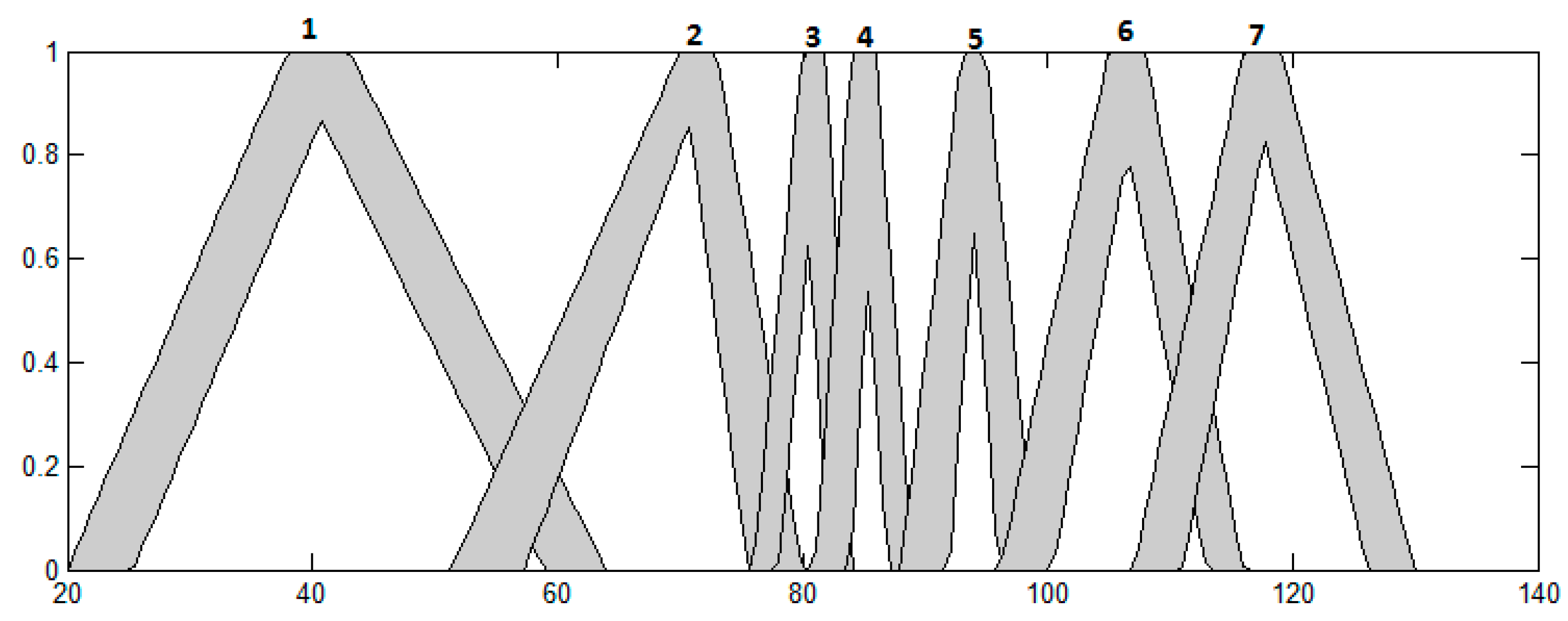


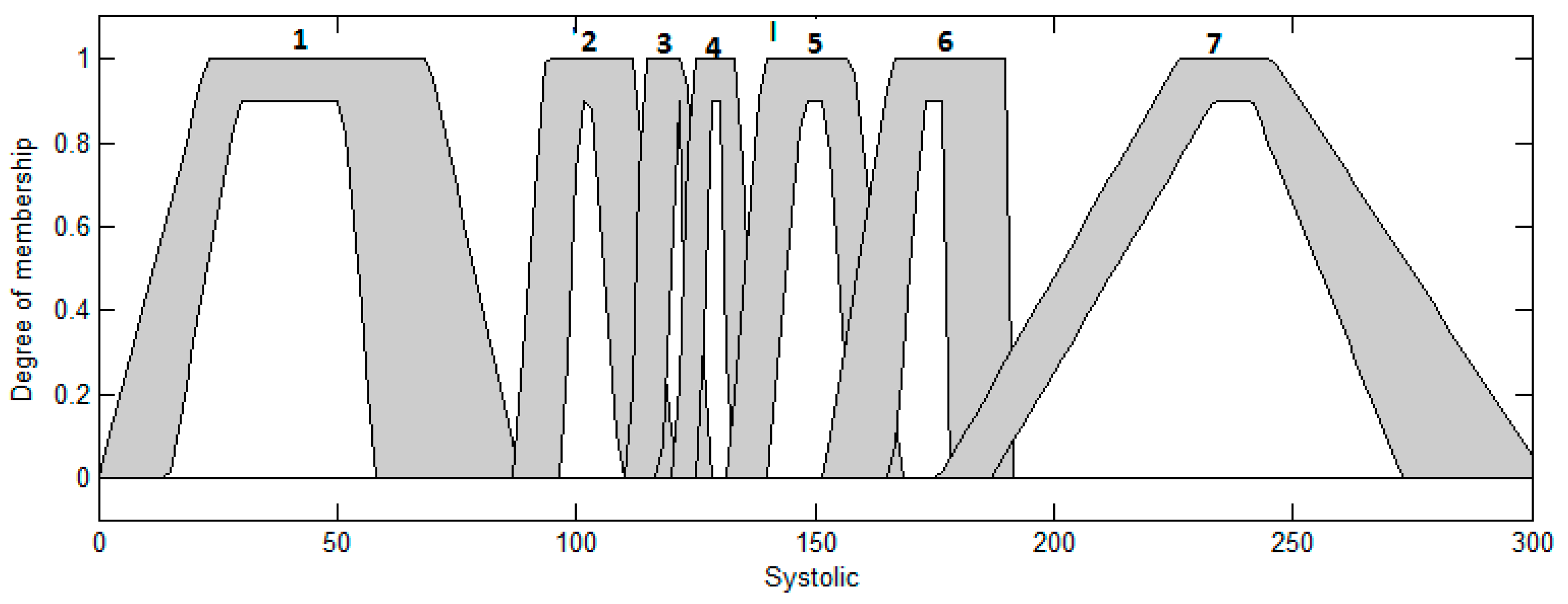

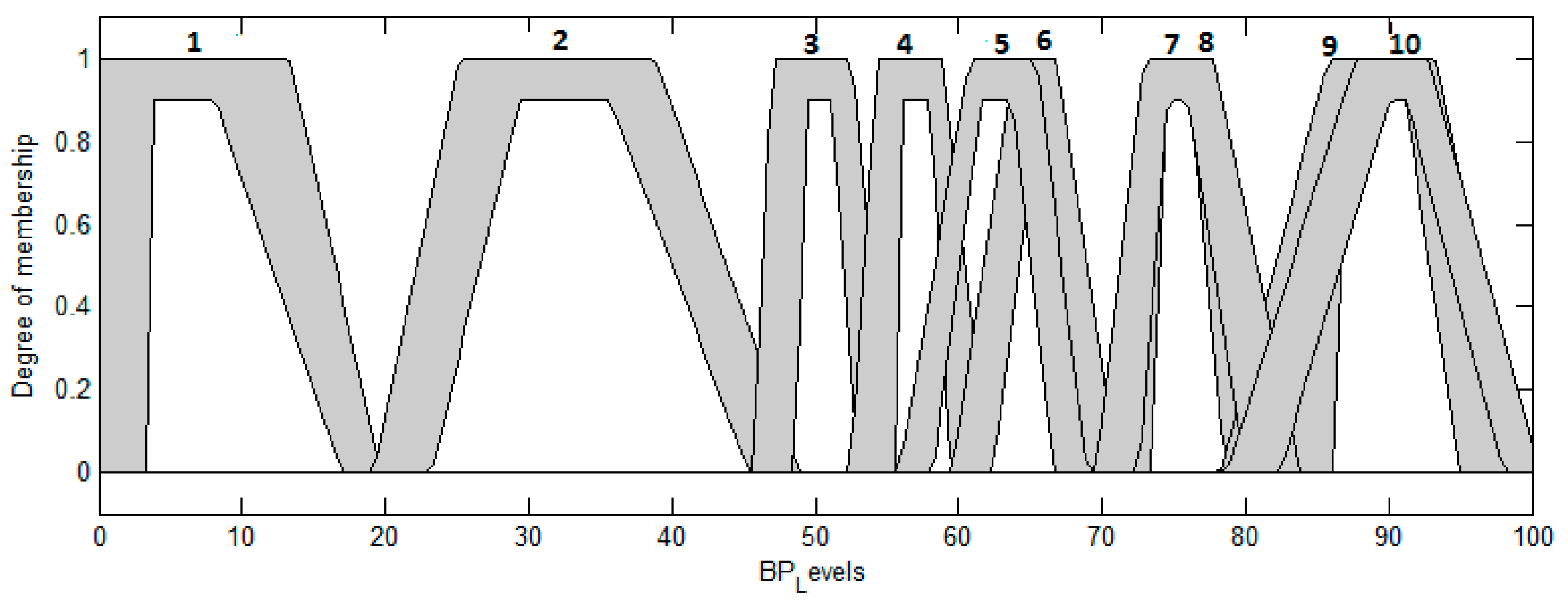


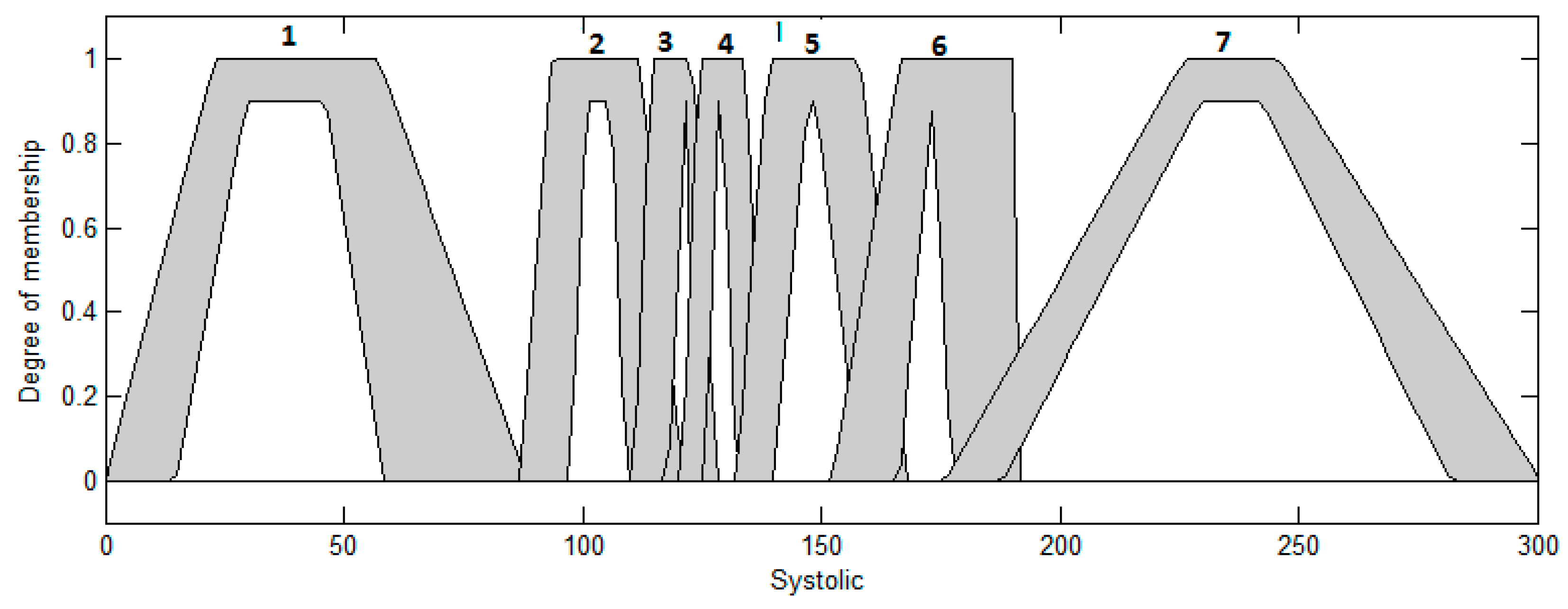
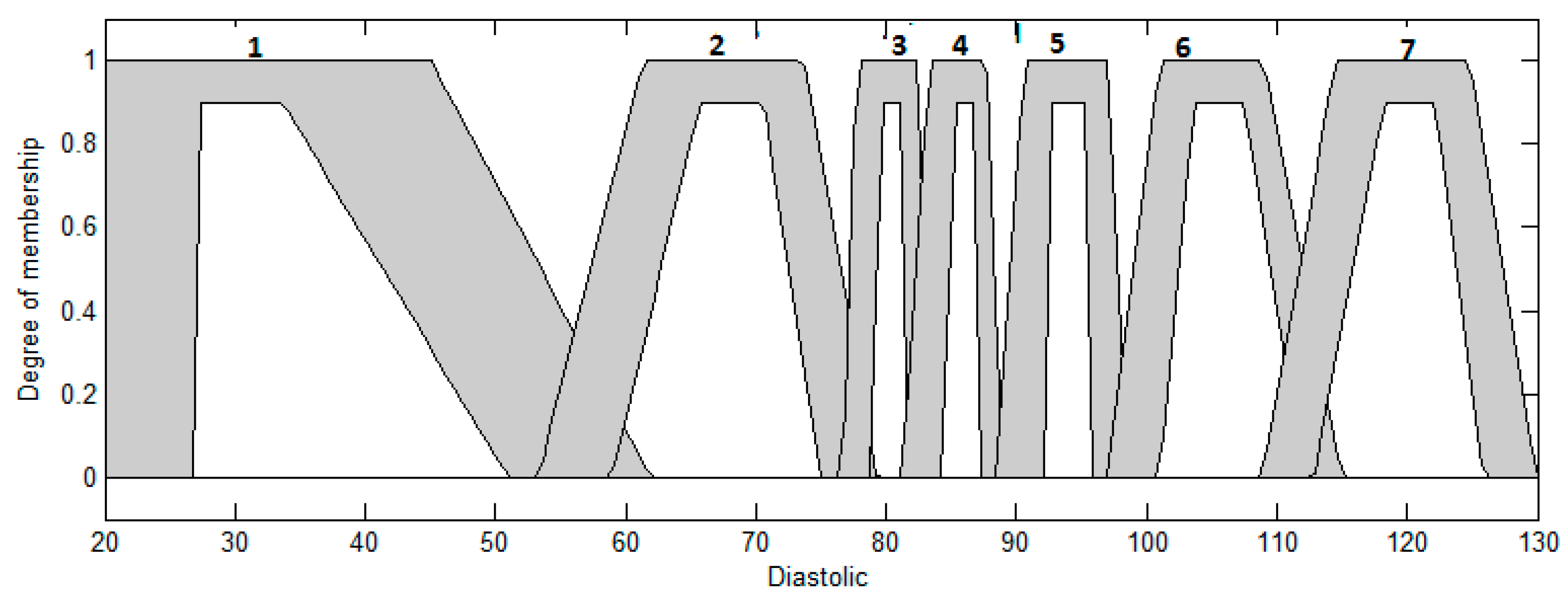
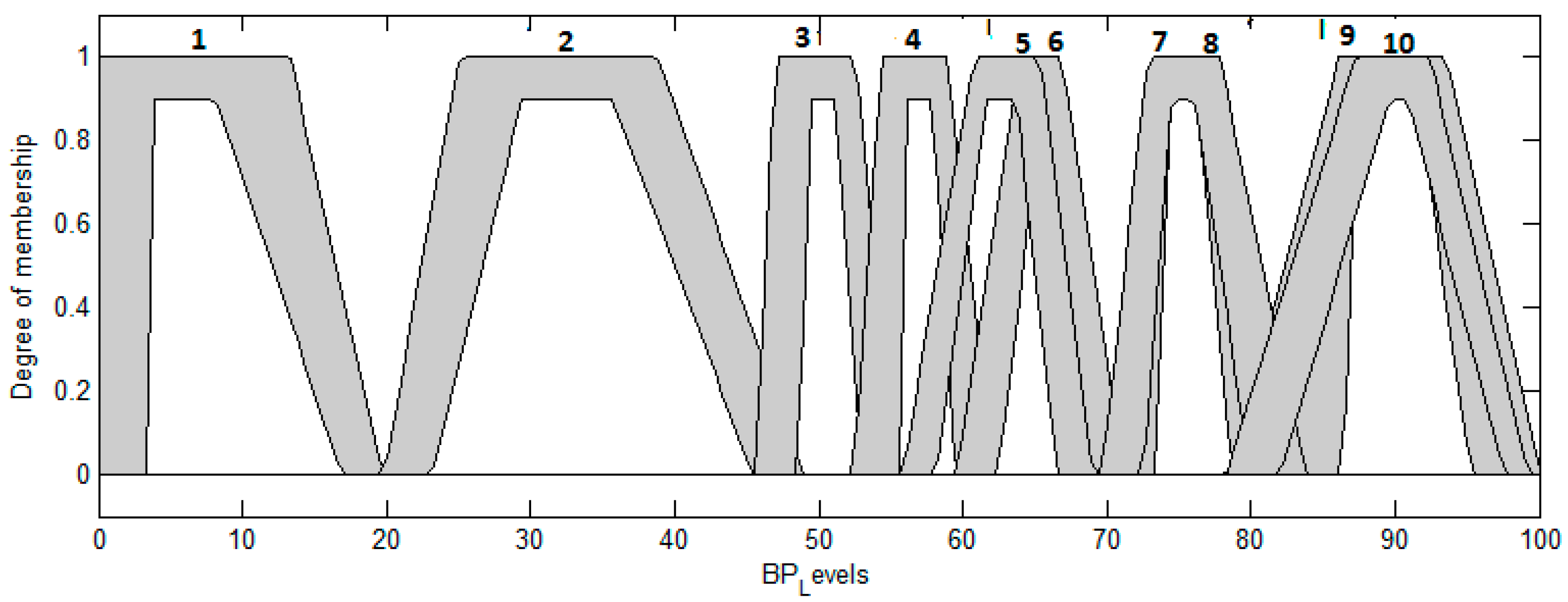
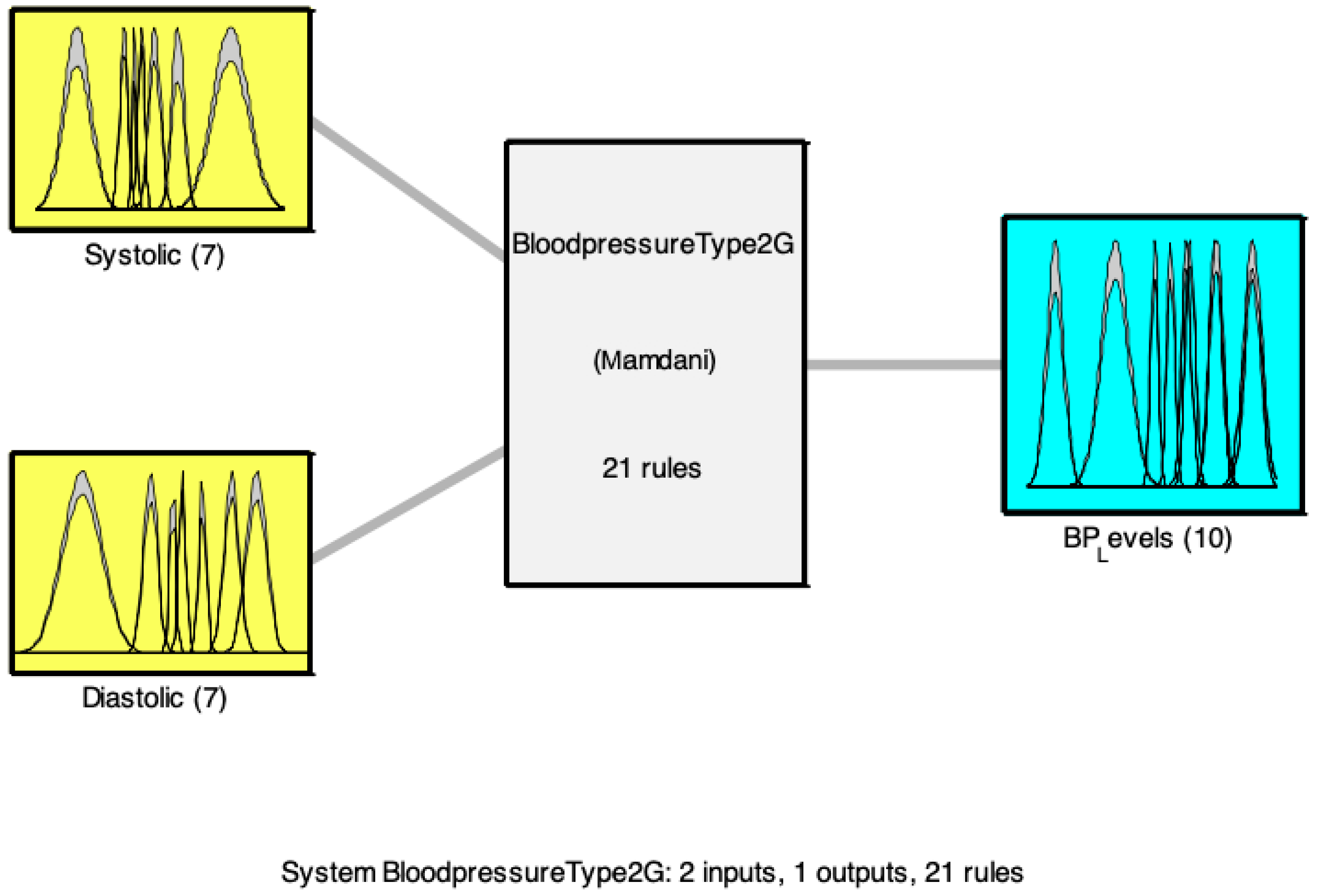

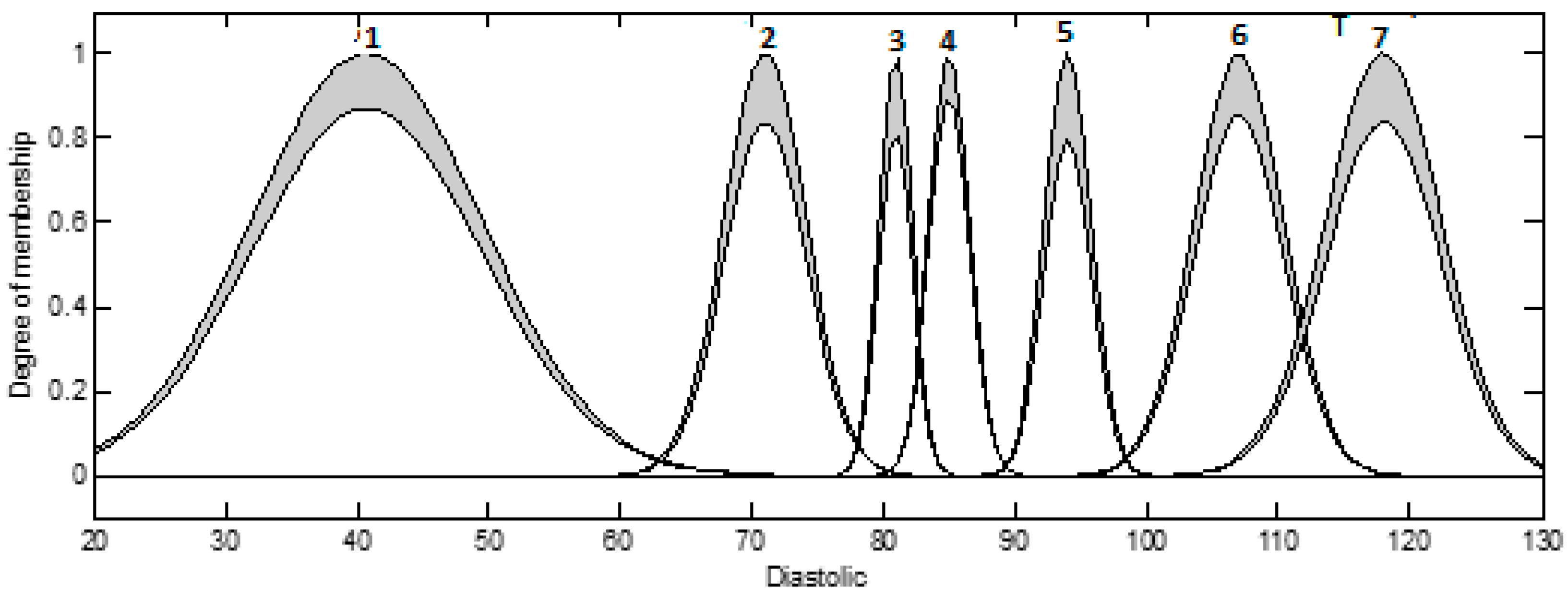
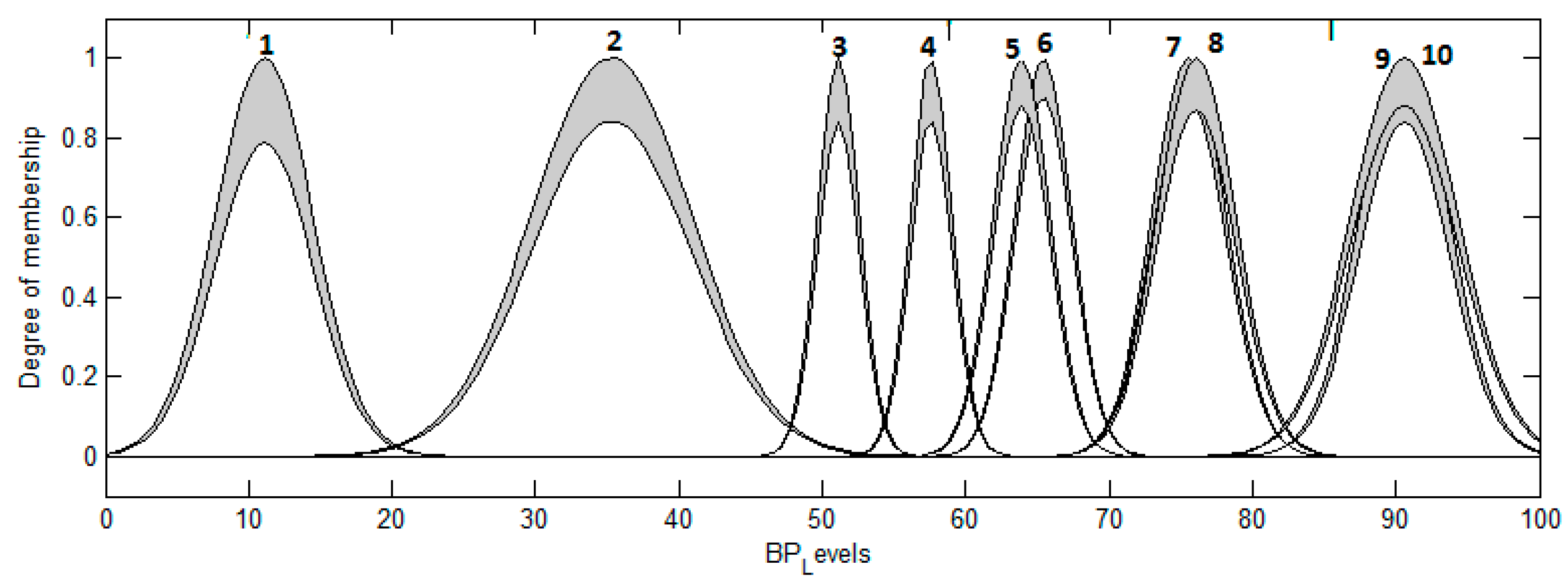



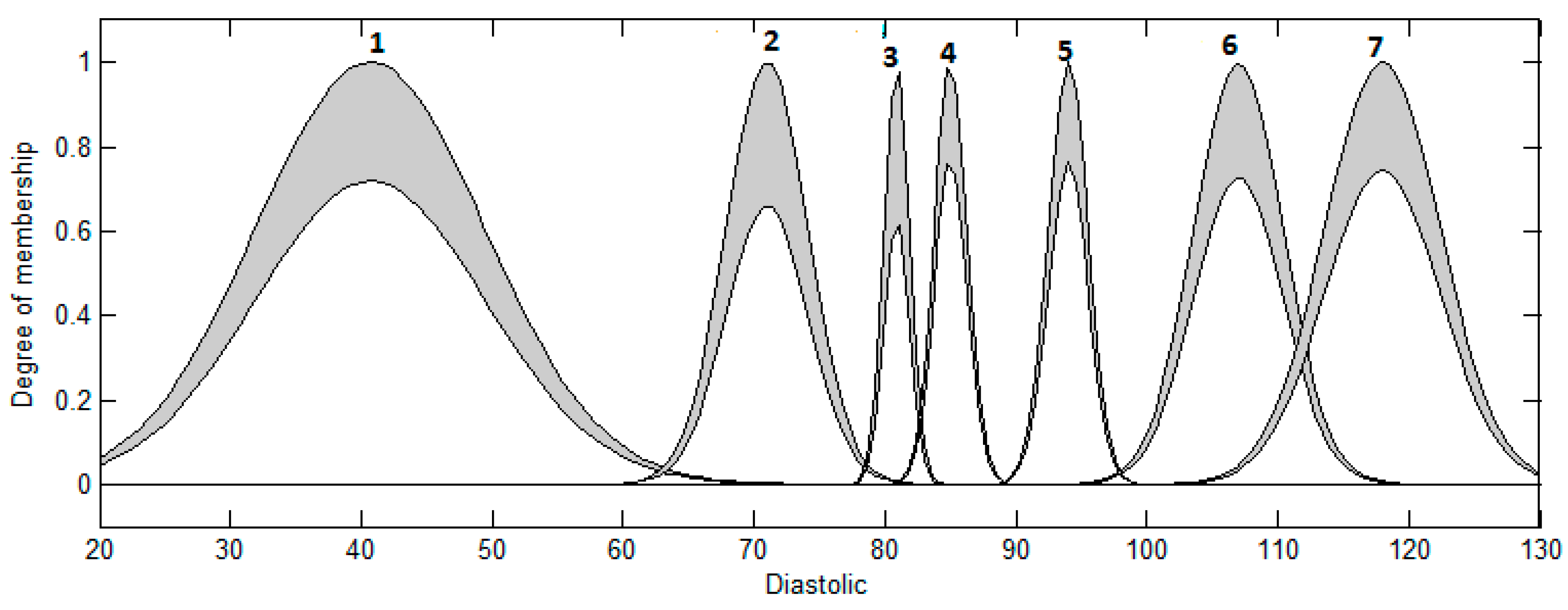
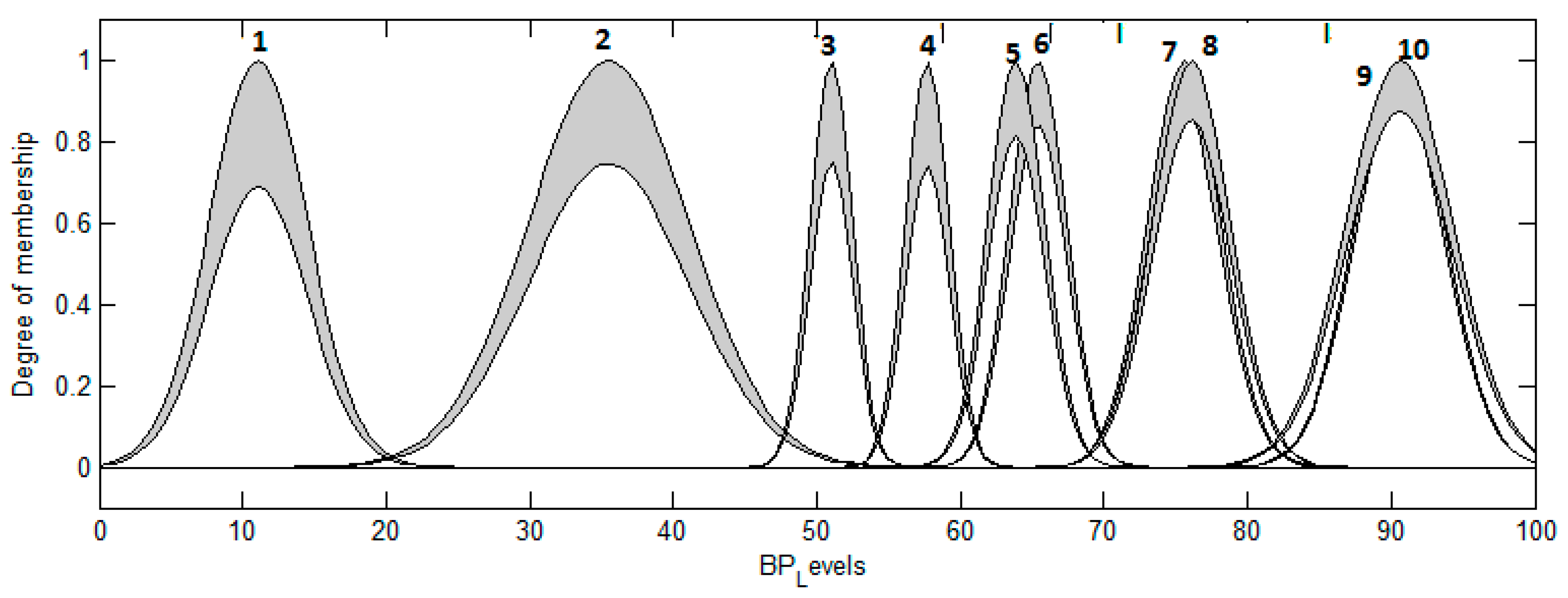
| Category | Systolic | Diastolic | |
|---|---|---|---|
| Hypotension | <90 | and/or | <60 |
| Optimal | <120 | and | <80 |
| Normal | 120–129 | and/or | 80–84 |
| High Normal | 130–139 | and/or | 85–89 |
| Grade 1 Hypertension | 140–159 | and/or | 90–99 |
| Grade 2 Hypertension | 160–179 | and/or | 100–109 |
| Grade 3 Hypertension | ≥180 | and/or | ≥110 |
| Isolated systolic hypertension | ≥140 | and | <90 |
| Genetic Algorithm | Generation | Population | Selection Method | Mutation Rate | Crossing Rate |
|---|---|---|---|---|---|
| GA 1 | 100 | 100 | roulette wheel | 0.06 | 0.5 |
| GA 2 | 100 | 100 | roulette wheel | 0.04 | 0.6 |
| GA 3 | 100 | 100 | roulette wheel | 0.06 | 0.7 |
| Experiments with 45 Systolic and Diastolic Samples from the 24 h Monitoring | |||
|---|---|---|---|
| Patients | Correct Classification Percentage of the Optimized Classifier T1 (Triangular) | Correct Classification Percentage of the Optimized Classifier T1 (Trapezoidal) | Correct Classification Percentage of the Optimized Classifier T1 (Gaussians) |
| 1 | 93.33 | 97.78 | 93.33 |
| 2 | 100 | 93.33 | 93.33 |
| 3 | 93.33 | 97.78 | 93.33 |
| 4 | 100 | 97.78 | 80 |
| 5 | 100 | 93.33 | 95.56 |
| 6 | 97.78 | 100 | 77.78 |
| 7 | 93.33 | 93.33 | 95.56 |
| 8 | 97.78 | 93.33 | 95.56 |
| 9 | 97.78 | 97.78 | 80 |
| 10 | 100 | 77.78 | 84.44 |
| 11 | 100 | 93.33 | 100 |
| 12 | 97.78 | 93.33 | 95.56 |
| 13 | 100 | 97.78 | 93.33 |
| 14 | 97.78 | 93.33 | 93.33 |
| 15 | 100 | 97.78 | 100 |
| 16 | 97.78 | 100 | 95.56 |
| 17 | 100 | 93.33 | 84.44 |
| 18 | 97.78 | 93.33 | 84.44 |
| 19 | 100 | 77.78 | 93.33 |
| 20 | 93.33 | 97.78 | 93.33 |
| 21 | 100 | 86.66 | 95.56 |
| 22 | 100 | 93.33 | 93.33 |
| 23 | 97.78 | 86.66 | 95.56 |
| 24 | 97.78 | 93.33 | 86.66 |
| 25 | 100 | 77.78 | 95.56 |
| 26 | 97.78 | 77.78 | 95.56 |
| 27 | 100 | 97.78 | 95.56 |
| 28 | 97.78 | 93.33 | 86.66 |
| 29 | 93.33 | 77.78 | 95.56 |
| 30 | 97.78 | 93.33 | 95.56 |
| Average | 98.00033333 | 91.925 | 91.926 |
| Experiments with 45 Systolic and Diastolic Samples from the 24 h Monitoring | |||
|---|---|---|---|
| Patients | Correct Classification Percentage of the Optimized Classifier T2 (Triangular) | Correct Classification Percentage of the Optimized Classifier T2 (Trapezoidal) | Correct Classification Percentage of the Optimized Classifier T2 (Gaussians) |
| 1 | 100 | 97.78 | 93.33 |
| 2 | 100 | 93.33 | 95.56 |
| 3 | 100 | 97.78 | 93.33 |
| 4 | 100 | 97.78 | 95.56 |
| 5 | 100 | 93.33 | 95.56 |
| 6 | 100 | 100 | 77.78 |
| 7 | 97.78 | 93.33 | 95.56 |
| 8 | 100 | 93.33 | 95.56 |
| 9 | 100 | 97.78 | 95.56 |
| 10 | 100 | 93.33 | 84.44 |
| 11 | 100 | 97.78 | 100 |
| 12 | 97.78 | 93.33 | 95.56 |
| 13 | 100 | 97.78 | 93.33 |
| 14 | 97.78 | 93.33 | 93.33 |
| 15 | 100 | 97.78 | 100 |
| 16 | 100 | 100 | 95.56 |
| 17 | 100 | 93.33 | 84.44 |
| 18 | 100 | 93.33 | 93.33 |
| 19 | 100 | 97.78 | 93.33 |
| 20 | 100 | 97.78 | 93.33 |
| 21 | 100 | 86.66 | 95.56 |
| 22 | 100 | 93.33 | 93.33 |
| 23 | 100 | 86.66 | 95.56 |
| 24 | 97.78 | 93.33 | 86.66 |
| 25 | 100 | 97.78 | 95.56 |
| 26 | 97.78 | 93.33 | 95.56 |
| 27 | 100 | 86.66 | 95.56 |
| 28 | 97.78 | 86.66 | 95.56 |
| 29 | 97.78 | 86.66 | 95.56 |
| 30 | 97.78 | 97.78 | 95.56 |
| Average | 99.408 | 94.2946667 | 93.6306667 |
| Results for Type-1 Fuzzy Systems | |||
|---|---|---|---|
| Classifier T1 (Triangular MF) | Classifier T1 (Trapezoidal MF) | Classifier T1 (Gaussians MF) | |
| Average: | 98% | 91.925% | 91.926% |
| Variance | 5.57 | 51.25 | 34.92 |
| Standard Deviation | 2.36 | 7.16 | 5.91 |
| Results for Type-2 Fuzzy System | |||
|---|---|---|---|
| Classifier T2 (Triangular MF) | Classifier T2 (Trapezoidal MF) | Classifier T2 (Gaussians MF) | |
| Average: | 99.408% | 94.29% | 93.63% |
| Variance | 0.997 | 17.29 | 21.04 |
| Standard Deviation | 0.998 | 4.16 | 4.59 |
© 2019 by the authors. Licensee MDPI, Basel, Switzerland. This article is an open access article distributed under the terms and conditions of the Creative Commons Attribution (CC BY) license (http://creativecommons.org/licenses/by/4.0/).
Share and Cite
Guzmán, J.C.; Miramontes, I.; Melin, P.; Prado-Arechiga, G. Optimal Genetic Design of Type-1 and Interval Type-2 Fuzzy Systems for Blood Pressure Level Classification. Axioms 2019, 8, 8. https://doi.org/10.3390/axioms8010008
Guzmán JC, Miramontes I, Melin P, Prado-Arechiga G. Optimal Genetic Design of Type-1 and Interval Type-2 Fuzzy Systems for Blood Pressure Level Classification. Axioms. 2019; 8(1):8. https://doi.org/10.3390/axioms8010008
Chicago/Turabian StyleGuzmán, Juan Carlos, Ivette Miramontes, Patricia Melin, and German Prado-Arechiga. 2019. "Optimal Genetic Design of Type-1 and Interval Type-2 Fuzzy Systems for Blood Pressure Level Classification" Axioms 8, no. 1: 8. https://doi.org/10.3390/axioms8010008
APA StyleGuzmán, J. C., Miramontes, I., Melin, P., & Prado-Arechiga, G. (2019). Optimal Genetic Design of Type-1 and Interval Type-2 Fuzzy Systems for Blood Pressure Level Classification. Axioms, 8(1), 8. https://doi.org/10.3390/axioms8010008







